
Subscribe to my YouTube channel for video reviews.

Trek Road Bikes Guide: Domane vs. Émonda vs. Madone
CyclistsHub is supported by its readers. We may receive a commission if you buy products using our links.
Trek’s road bike lineup consists of Domane, Émonda, and Madone . Below, I will explain their differences and advise you on which one to buy.
The short answer is as follows:
- Domane has the most relaxed geometry . It’s a versatile endurance road bike for the masses, suitable for beginners and intermediate riders.
- Émonda is a performance-oriented lightweight road bike for more serious cyclists or pros.
- Madone is a pure-blood aero racing bike for demanding riders and racers.
Continue reading for more details, the differences between ALR, SL, and SLR, and much more.
Domane vs. Émonda vs. Madone
Here’s a closer look at these 3 models and their main features.
Trek Domane: All About Comfort
Domane could be classified as an endurance road bike. This means a relaxed geometry that doesn’t push you into as aggressive a position as Émonda or Madone.
Domane sits somewhere between those two. It’s reasonably aero and lightweight but doesn’t excel in any of these categories.
On the other hand, it has a wide tire clearance , so you can equip it with wide tires (up to 38mm), which are more comfortable. This means we can also classify it as a gravel bike and compare it with Trek Checkpoint .
It features an IsoSpeed decoupler , which absorbs shock and vibrations, making the ride smoother and more comfortable.
You can see I mentioned comfort several times. That’s because Domane is all about comfort .
Price-wise, it is Trek’s most affordable road bike line.
Trek Émonda: Lightweight Yet Aero Racing Bike
Émonda is a lightweight road bike designed for racing. It has more performance geometry than Domane.
It’s not as aero as Madone, but more aero than Domane. It’s also lighter, making it ideal for climbing and riders who want an agile bike.
Since the 2021 redesign, it can be classified as a hybrid road bike (lightweight yet aero), following this industry trend.
It doesn’t have fancy features like the decoupler to keep things simple. So together with its more aggressive geometry, it means it is less comfortable than Domane.
Trek Madone: Aero Is Everything
Madone is a pure-blood aero road bike with racing geometry suitable for flats and rolling terrain.
It’s stiff to transfer the power you put into pedals efficiently. It’s so stiff that it requires getting used to. One of my friends couldn’t get used to it because of its stiffness.
Since the 2022 redesign, it doesn’t have an IsoSpeed decoupler anymore (Gen 6), but Trek introduced IsoFlow , radically changing how this frame looks (Gen 7).
Madone is a go-to choice for sprinters and people who know what to expect from their bikes.
On the other hand, it’s probably the least comfortable road bike from Trek’s lineup.
Trek Road Bikes Range Explained
You already know the differences between Domane, Émonda, and Madone. But what do the abbreviations and numbers in their names mean (e.g., Trek Madone SLR 7)?
The abbreviation refers to the frame material. The key is as follows:
- ALR are aluminum frame bikes.
- SL are bikes with 500 series OCLV* carbon (mid-range).
- SLR are bikes with 800 series OCLV carbon (high-end).
*OCLV carbon is Trek’s patented carbon fiber process ( learn more ).
And the numbers mean the groupset:
- Models ending with 2 use Shimano Claris (R2000) groupset.
- Models ending with 3 use Shimano Sora (R3000) groupset.
- Models ending with 4 use Shimano Tiagra (R4700) groupset.
- Models ending with 5 use Shimano 105 (R7000) groupset.
- Models ending with 6 use Shimano 105 Di2 (R7100) or SRAM Rival AXS groupsets.
- Models ending with 7 use Shimano Ultegra Di2 (R8100) or SRAM Force AXS groupsets.
- Models ending with 9 use Shimano Dura-Ace Di2 (R9200) or SRAM Red AXS groupsets.
When comparing Trek road bike models and their specs, I found that bikes with SRAM are heavier and more expensive than those with Shimano groupsets, even though SRAM groupsets are usually cheaper than Shimano on their own.
So, I recommend buying a Trek road bike with a Shimano groupset unless you want to try SRAM or prefer it.
The AL models are aluminum and good for beginners because they are affordable. The SL models are made of 500 OCLV carbon and are suitable for most people , while the SLR models, made of 800 OCLV carbon, are perfect for more demanding riders .
The Domane AL line is versatile and comfortable , thanks to wider tires and relaxed geometry. The AL 4 with the Tiagra groupset (2x10spd) offers the best value, in my opinion.
The Émonda line is for racers and those who like slimmer tubes. Its racing geometry pushes you into a more aerodynamic position than Domane, and its lower weight allows for better responsiveness and handling. I believe the Émonda SL 6 with Shimano 105 Di2 is the best option and much cheaper than higher-end models.
Finally, Madone is for those who want aero properties and aggressive racing geometry . The 7th generation offers beautiful bikes that stand out thanks to the IsoFlow. The previous generation was pretty heavy and “old school.” Choose a model that fits your budget. I suggest the Madone SL 7 with Shimano Ultegra Di2 because of its hidden buttons.
Trek Road Bikes FAQ
Trek road bike frames are made in Asia (mainly in Taiwan and China). Then they are shipped to Wisconsin, where they are painted and assembled. However, the design and R&D center is still in Wisconsin, US. ( Source )
Project One is Trek’s program for customizing road bikes (Domane, Émonda, Domane, Speed Concept). You can choose specific color options and some components to match your liking and preference.
Some models have women-specific options. However, in recent years, Trek has addressed women’s sizing by listing more bike sizes (e.g., size 44), with the smaller sizes being more suitable for women.
Trek sponsors only the team Trek-Segafredo. It belongs to the less successful teams based on the World Tour wins. See more details in my bicycle brands article .
Trek offers a lifetime frame warranty. However, it’s only valid for the first owner. The second (and subsequent) owners have a shorter, 3-year warranty. You can read the Trek warranty page for more info.
IsoSpeed is Trek’s technology for absorbing vibrations from the frame and seatpost that would otherwise be transferred to your body. Learn more about IsoSpeed .
IsoFlow is Trek’s frame feature that makes Madone aero road bikes (according to Trek) faster and lighter than those with IsoSpeed. This technology should also improve riding comfort. Learn more about IsoFlow .
About The Author
Petr Minarik
Leave a comment cancel reply.
Your email address will not be published. Required fields are marked *
Save my name, email, and website in this browser for the next time I comment.
Start typing and press enter to search
- Skip to primary navigation
- Skip to main content

Cycling Road
Trek Emonda, Madone, and Domane: Which Road Bike is Right for You
Have you decided on Trek for your next road bike but are not sure which one to get? This article can help. There are 3 categories of road bikes that Trek makes: the Emonda, the Madone, and the Domane. The difference between these three bikes is in their geometry, tube profiles, and weight. You might be wondering why this matters so much – it’s because a bike will feel and perform very differently depending on those three things. So if you want to know which one is right for you then keep reading!

The short answer
– The Emonda is a lightweight race bike for cyclists who like to go fast and ride aggressively. The lightness of Emonda is perfect for climbing because lighter bikes require less effort to get your bike up hills.
– The Madone is a bit heavier than the Emonda but has an aerodynamic design that makes this bike great for flat terrains. The IsoFlow below the Madone’s seatpost absorbs shocks while allowing air to flow better, which makes this bike more comfortable and aero than the Emonda.
– The Domane’s geometry is more upright than Emonda and Madone, making it a great touring bike for long distances. The Domane can fit wider tires and has the IsoSpeed Decoupler on the seat post that allows small deflection which absorbs road vibration, making it perfect if you plan on doing a lot of off-road riding or going over rough terrain.
Domane is also the only road bike in Trek’s range available at a sub $2000 price point, which makes it the best option for beginners. Although, the alloy Domane AL doesn’t have the same IsoSpeed technology.
Okay, so maybe that was too quick. Let’s talk about each Trek road bike in more detail.
Emonda: The Lightweight, Semi-Aero Race Bike
This is Trek’s lightest bike and it is meant for cyclists who like to go fast. The 2021 and later model has a semi-aero design which means that the tubing of this bike has been shaped in order to decrease its aerodynamic drag, making you faster on flat terrain (and on the climb too, if you’re fast enough).
Emonda is great for climbing because it is lightweight so it requires less effort to get your bike up hills.
Why you should choose the Emonda:
– If you like to go fast and ride aggressively, the Emonda is a great choice for you.
– The light weight of this bike will make climbing easier. If you live in an area with lots of hills and long climbs, the Emonda will be perfect for you.
– You want an agile bike with quick handling that makes you feel fast
Why you should not choose the Emonda:
– If comfort is what matters most to you then this bike might not be your first choice. The Emonda’s lightweight carbon layup is so harsh that you will feel every road imperfection. That said, the harshness is not always a bad thing for experienced riders. Plus, you can use 28mm tires or tubeless setup to make it more comfortable.
– The semi-aero design means that while it is lighter, it’s not as fast compared to other aero bikes, including the Madone in flat road. So if you live in a very flat area or hate climbing, you might want to choose the Madone instead because the weight penalty won’t matter to you.
– You are looking for a bike that can handle rough terrain since the Emonda is not built for this. Go for Domane or Trek’s gravel bike, Checkpoint.
Madone: The Fast, Aerodynamic Race Bike
The Madone is Trek’s most popular road bike model and it has an aerodynamic design which makes this bike great for flat terrains. It has the IsoFlow technology which helps absorbs road vibration and allows a better airflow to reduce drag.
The geometry of the Madone is the exact same as the Emonda. This bike has a bit more weight but this will be unnoticeable when you’re not going uphill, making this bike great if speed matters to you and you live in an area with lots of flats.
Why you should choose the Madone:
– You ride in flat or rolling terrains and want a fast bike that is comfortable
– You are looking for an aerodynamic advantage, especially on flat roads
– You are looking for a stiff bike for sprints
Why you should not choose the Madone:
– If you ride long climbs. Yes, descending with a Madone is a blast because of the aero benefits and stability when slicing through the wind, but the climb won’t be as much fun compared to an Emonda. (Not that it’s not doable.)
– You’re looking for an all-around bike that is quick on the climb and still relatively fast on the flat. The Emonda with its semi-aero profile is built exactly for this. Road Bike.
– You want a bike that can handle rough terrain, then the Madone might not be right for you because even with the IsoSpeed it is still a stiff bike. The Domane is for you.
Domane: The Long Distance Endurance Bike That Can Handle Rough Terrain
The Domane’s geometry is more upright than the Emonda and Madone making this bike perfect if you want to ride long distances. Unlike Emonda and Madone, the geometry of Domane focuses on stability.
The IsoSpeed Decoupler combined with large tire clearances means that you can even use Domane as a gravel bike if you want.
Why you should choose the Domane:
– You ride long distances . Though, keep in mind that you can still use Emonda and Madone for long-distance rides as most people do. Domane is just on a different level in terms of comfort.
– You want a bike that is comfortable and can handle rough terrain like gravel roads or even trails.
– You are looking for an upright geometry that will make your back less tired after many hours of riding.
– You want bikes with an integrated storage compartment. Useful for mini-tools, tubes, and snacks for long rides.
Why you should not choose the Domane:
– If speed is what matters most to you, then this bike might slow you down compared to Emonda and Madone. That said, it might be worth sacrificing a bit in terms of pure speed because the advantages are much more noticeable on long rides.
– You want light bikes. Domane is rather heavy, even heavier than the Madone.
– You want an agile bike. As an endurance bike, Domane’s geometry makes it a stable bike, but stability and agility is on the opposite side of the scale. It’s great for long-distance riding, but not what people prefer in racing bikes.
What kind of rider are you?
If you’re a beginner and not sure yet, I suggest that you choose the Emonda because it’s more versatile and offers better overall performance. The lightweight and agility of Emonda can be very addictive. Madone is a fast bike, but you probably won’t be able to appreciate its aero benefits just yet because most beginners ride at a speed where air resistance is not the significant force.
If you’re an experienced rider and are trying to get into the top 10 or even “KOM” on Strava flat segments, maybe Madone is for you. If you race in criteriums, then Madone might give you an advantage.
Normally, the comfort or stiffness of the bike is another factor for people when choosing between lightweight or aero bikes, because most aero bikes are harsh to ride. But Madone actually feels comfortable and smooth for an aero bike thanks to its IsoFlow technology. In fact, Madone might feel more comfortable than the Emonda.
Finally, choose Domane if you want an all-terrain bike or if your back really can’t handle the more aggressive Emonda and Madone.
Reader Interactions
October 4, 2022 at 2:36 am
this is great information! Unfortunately, about a year late, however ha ha. I bought my Emonda about a year ago and finding that perhaps a domane would be better suited for my taste and physical preference (50+ :-). I have a question, however… Is it possible to make the Emonda more “upright“ to favor the domane upright position? Perhaps with a different stem?
October 5, 2022 at 2:42 am
The Domane has about 10-20 mm shorter reach and 30-40 mm higher stack than an Emonda, maybe more in some different sizes. You can use a 20 mm shorter stem and flip it to a positive degree angle to get about the same stack and reach as the Domane. If you already use a short stem (90 mm or shorter), try changing the handlebar to one that has a shorter reach like the Zipp Service Course 70 with has a 70 mm reach compared to the Bontrager handlebars that your Emonda might come equipped with, which has a 100 mm reach.
October 16, 2022 at 7:54 am
Thanks for very helpful article – I am just in the middle of exactly this decision. I am leaning towards the Émonda as my new road bike. I have a slight hesitation on the comfort side. I ride mostly between 60 and 120 km, but will sometimes be doing longer rides up to 200 km. I am 55 years old but very active. I have a lot of hills around me and want to get better uphill so that’s a big attraction, and I am also pushed to keep up with the club I ride with. Do you think those kinds of distances would be ok. For info I have previously been riding a Lapierre Sensium, so the wider tyre on the sensium will certainly help to some degree. Also, I have a checkpoint as well which I love and would continue for gravel and bike packing etc.
November 10, 2022 at 1:27 pm
Thank you for this article. Came right on time. I saw a Domane that I really liked and I was about to purchase it however it did seem kind of heavy. Based on this article I think the Emonda would be the best for triathlon training.
July 8, 2023 at 12:05 am
I would love a madone. But at 55, I’m not sure it would make much difference in my riding. I have a Domane and slammed the stem, made changes to the angle of the bars, got continental tires and try to ride more Aero. It helped and I’m faster but I doubt that the cost difference between domaine and madone could be justified.
Leave a Reply Cancel reply
Your email address will not be published. Required fields are marked *
Save my name, email, and website in this browser for the next time I comment.
This site uses Akismet to reduce spam. Learn how your comment data is processed .
Cycling school
Emonda, Madone, Domane: Your Perfect Road Bike?

Have you chosen Trek as your potential brand for the next road bike adventure, yet you’re uncertain about the specific model? This informative piece is here to assist you. Trek offers three distinct categories of road bikes: the Emonda, the Madone, and the Domane. The key distinctions among these bicycles lie in their geometry, tube designs, and weight. The significance of these factors is substantial as they profoundly influence how a bike handles and performs. If you’re eager to determine the ideal choice for your needs, continue perusing this article!
Deciding Between Trek Road Bikes: An In-Depth Comparison
In a nutshell:
- The Emonda: A feather-light racing bike tailored for those who crave speed and an aggressive riding style. Its lightweight nature makes it a prime choice for uphill climbs, requiring less effort to conquer hills;
- The Madone: Slightly heavier than the Emonda, the Madone boasts an aerodynamic design that excels on flat terrains. Incorporating IsoFlow technology beneath the seatpost, it efficiently absorbs shocks and enhances airflow, delivering a comfortable and aerodynamic experience surpassing the Emonda;
- The Domane: Differing from the Emonda and Madone, the Domane showcases a more upright geometry, rendering it an excellent touring companion for covering extended distances. With its ability to accommodate wider tires and equipped with the IsoSpeed Decoupler on the seat post, it absorbs road vibrations through slight deflection. This quality proves invaluable for off-road ventures or traversing uneven landscapes.
Moreover, the Domane stands out as the sole road bike within Trek’s lineup available at a sub $2000 price point, an ideal starting point for newcomers. However, it’s important to note that the alloy Domane AL lacks the same IsoSpeed technology.
If that overview felt a bit hasty, fear not. Let’s delve deeper into the specifics of each Trek road bike model.
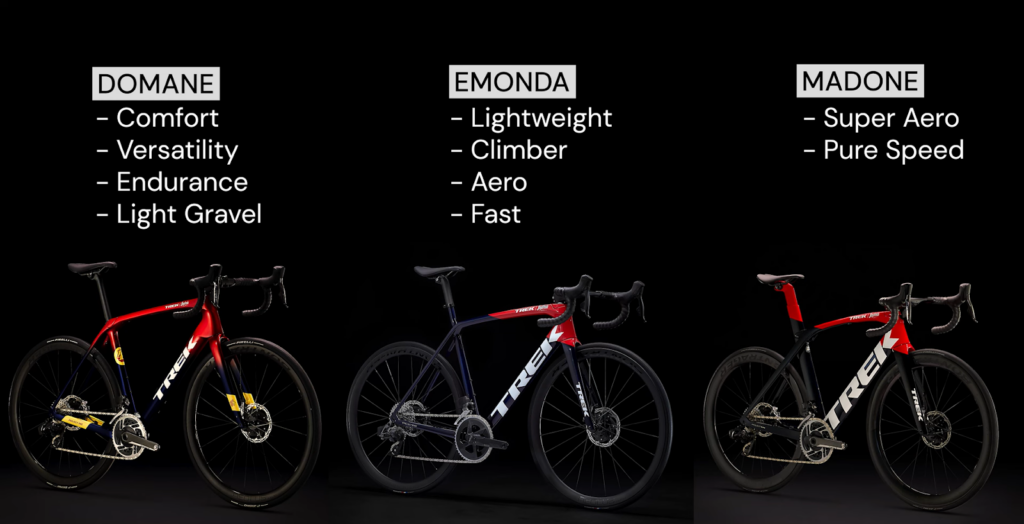
Emonda: The Feather-Light, Semi-Aero Racing Dynamo
Meet Trek’s embodiment of speed and lightness – the Emonda. Crafted for the avid speed enthusiast, this bike is a champion of rapidity. The 2021 and subsequent models flaunt a semi-aero construction, meticulously shaping the bike’s tubing to slice through the air with reduced drag. This results in heightened speed on both level surfaces and uphill stretches, given you possess the prowess to maintain pace.
Climbing, a realm where effort meets elevation, becomes a triumphant feat with the Emonda’s feather-like demeanor. Its lithe structure diminishes the exertion required to conquer ascents.
Reasons to Embrace the Emonda:
- If velocity and an assertive riding style are your passion, the Emonda beckons as your ideal companion;
- Effortless hill conquests await thanks to its weightlessness. For those residing in hilly domains with extended ascents, the Emonda stands as an impeccable ally;
- Nimble and responsive, this bike’s agile handling imbues a sense of velocity that’s palpable.
Factors to Ponder Before Opting for the Emonda:
- Should comfort reign supreme in your biking aspirations, the Emonda might not claim the throne. The bike’s lightweight carbon composition, while aiding speed, transmits road irregularities profoundly. Yet, for seasoned riders, this raw feedback could be a boon. Experimenting with 28mm tires or a tubeless setup can augment comfort;
- The semi-aero architecture, while enhancing lightness, might not match the velocity of dedicated aero bikes, notably the Madone, on flat roads. If your abode is a particularly flat terrain or ascents are your adversary, the Madone might emerge as the favored choice, regardless of the incremental weight;
- For ventures into rugged terrains, the Emonda doesn’t boast the pedigree. If unpaved paths and challenging landscapes are your destinations, set your sights on the Domane or Trek’s gravel offering, the Checkpoint.
In the realm of swift pursuits, the Emonda stands as a beacon. It beckons those who revel in the symphony of velocity and the challenge of uphill mastery.
Madone: The Swift and Aerodynamic Racing Dynamo
At the heart of Trek’s road bike offerings lies the renowned Madone – a model celebrated for its aerodynamic finesse. Engineered to conquer flat expanses with unrivaled speed, the Madone’s design is an embodiment of aerodynamic prowess. Embedded within its structure is the IsoFlow technology, seamlessly absorbing road vibrations while optimizing airflow to minimize drag.
The Madone’s geometry mirrors that of the Emonda, presenting a kinship in form. Although slightly heftier, this weight differential fades into insignificance when cruising on level terrain. For those in pursuit of velocity within flat landscapes, the Madone emerges as a compelling choice.
Reasons to Embrace the Madone:
- Your journey unfolds across flat or gently undulating terrains, and you seek a swifter, yet comfortable ride;
- The allure of aerodynamic supremacy beckons, particularly on straight, level pathways;
- Your quest entails harnessing a rigidity that excels in sprinting.
Factors to Consider Before Adopting the Madone:
- If your routes are marked by extended climbs, the Madone might relinquish a touch of the joy experienced with the Emonda. Descending aboard a Madone is a thrill due to its aerodynamic merits and wind-cutting stability, yet uphill pursuits might not match the Emonda’s exhilaration. (Though, certainly not implausible.);
- For a well-rounded companion capable of both nimble ascents and impressive flat speed, the Emonda, with its semi-aero configuration, fits the bill precisely;
- In your quest for a ride adept at handling rugged landscapes, the Madone might not be the prime choice, even with the IsoSpeed feature. If versatile performance is your aim, the Domane is designed to meet your needs.
In the universe of velocity and streamlined grace, the Madone stands tall. It beckons those enticed by the siren call of flat speed and aerodynamic dominance.
Domane: Endurance Steed for Distance & Terrain
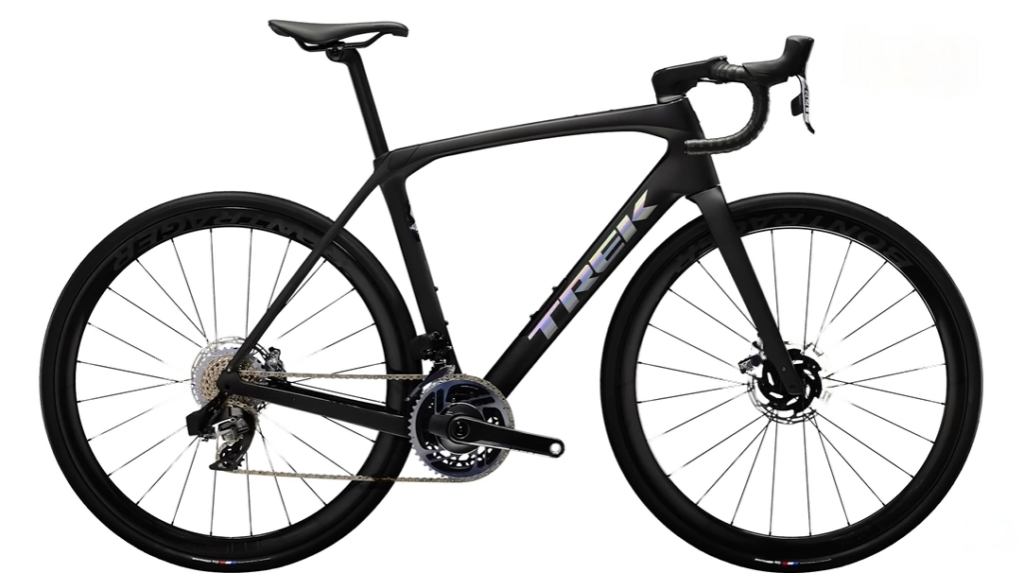
The Domane’s geometry sets it apart with its more upright stance in comparison to the Emonda and Madone, rendering it an optimal choice for those seeking prolonged rides. In contrast to the Emonda and Madone, the Domane’s geometry prioritizes stability, forming the backbone of its design philosophy.
Fortified by the IsoSpeed Decoupler and boasting generous tire clearances, the Domane transcends its role as a mere endurance bike – it’s equally adept as a gravel road explorer, and even a trail-taming companion if you dare.
Reasons to Embark on the Domane Journey:
- Your ventures encompass substantial distances. While it’s worth noting that the Emonda and Madone can indeed accommodate long rides, the Domane elevates comfort to an entirely new echelon;
- The allure of a comfortable ride capable of conquering rough terrains, including gravel roads and trails, beckons;
- Seeking an upright geometry that minimizes strain on your back during prolonged hours in the saddle;
- Integrated storage is on your checklist, catering to the needs of carrying mini-tools, spare tubes, and snacks during those extensive rides.
Factors to Reflect Upon Before Choosing the Domane:
- If speed reigns supreme, the Domane might not parallel the Emonda and Madone in this domain. However, consider the trade-off, as the advantages become notably conspicuous during lengthy excursions;
- If lightweight construction is a paramount concern, the Domane’s relatively heavier build, surpassing even the Madone, could pose a consideration;
- For agility enthusiasts, it’s important to recognize that while the Domane’s geometry infuses stability, agility takes a backseat. Suited for endurance endeavors, the Domane shines in extended journeys rather than the rapid pace of racing circuits.
In the realm of extended odysseys and rugged landscapes, the Domane reigns supreme. Its design harmonizes endurance, comfort, and versatility, making it the trusted companion for those who seek the open road and uncharted trails.
What Type of Cyclist Are You?
If you’re taking your initial pedal strokes in the expansive world of cycling, the Emonda beckons as a promising choice. Its versatile nature and well-rounded performance package make it an excellent entry point. The Emonda’s feather-light frame and responsive handling possess a magnetic allure that can easily captivate newcomers. In contrast, the Madone, with its emphasis on speed and aerodynamics, might not resonate as strongly with beginners who may not encounter substantial air resistance at their developing speeds.
For the seasoned riders who’ve felt the exhilaration of conquering steep climbs and dream of earning a place among Strava’s elite or clinching a coveted “KOM” title, the Madone stands tall as the answer. If criterium racing is your forte, the Madone’s aerodynamic edge might just tip the scales in your favor.
When the age-old dilemma between comfort and stiffness arises, often inherent in the choice between lightweight and aerodynamic bikes, the Madone defies convention. It bestows a pleasantly unexpected comfort, thanks to its IsoFlow technology, rivaling or even surpassing the comfort offered by the Emonda.
However, if your aspirations lead you to embrace a versatile companion for all terrains, or if the more aggressive riding postures of the Emonda and Madone strain your back, the Domane awaits with its accommodating geometry and endurance-oriented design. It thrives as the road bike of choice for those who seek comfort, stability, and a seamless transition from smooth roads to uncharted trails.
In the realm of Trek road bikes, the choice between Emonda, Madone, and Domane encapsulates the diverse desires of road cyclists. The Emonda’s lithe build beckons speed enthusiasts, infusing ascents with an air of conquest. The Madone, boasting aerodynamic excellence, invites those enamored with flat speed while surprising riders with its comfort. On the other hand, the Domane’s endurance-focused design and versatility cater to adventurers who seek comfort on extended journeys, even when the path veers off-road. Whether you chase the thrill of uphill battles, the rush of aerodynamic dominance, or the comfort of enduring vast distances, Trek offers a model that aligns with your road cycling aspirations.
Ruelas Larry
2023 Trek Emonda vs Madone vs Domane
The current Trek road bike lineup, the Emonda, Madone and Domane offer a blend of innovation, performance, and style. Bike expert Alex Lee compares these Trek models, discussing their features, builds, and pricing.
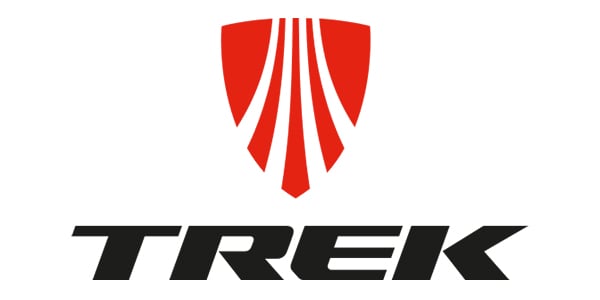
Trek bike names are easy to understand. There are three distinct models; Emonda , Madone , and Domane . Each model is designed to perform well in a particular type of ride.
The general rule of thumb below will give you a clear idea of what the bike is about, where it sits in the lineup, and how it’s specced.
- SLR models use the top-of-the-line OCLV 800 carbon.
- SL models use the mid-range, OCLV 500 carbon.
- ALR is for aluminum frames.
- Models ending with 9 use Shimano Dura-Ace Di2 or SRAM Red AXS groupsets.
- Models ending with 7 use Shimano Ultegra Di2 or SRAM Force AXS groupsets.
- Models ending with 6 use Shimano 105 Di2 or SRAM Rival AXS groupsets.
- Models ending with 5 use Shimano 105 R7000 groupset.
Trek Emonda
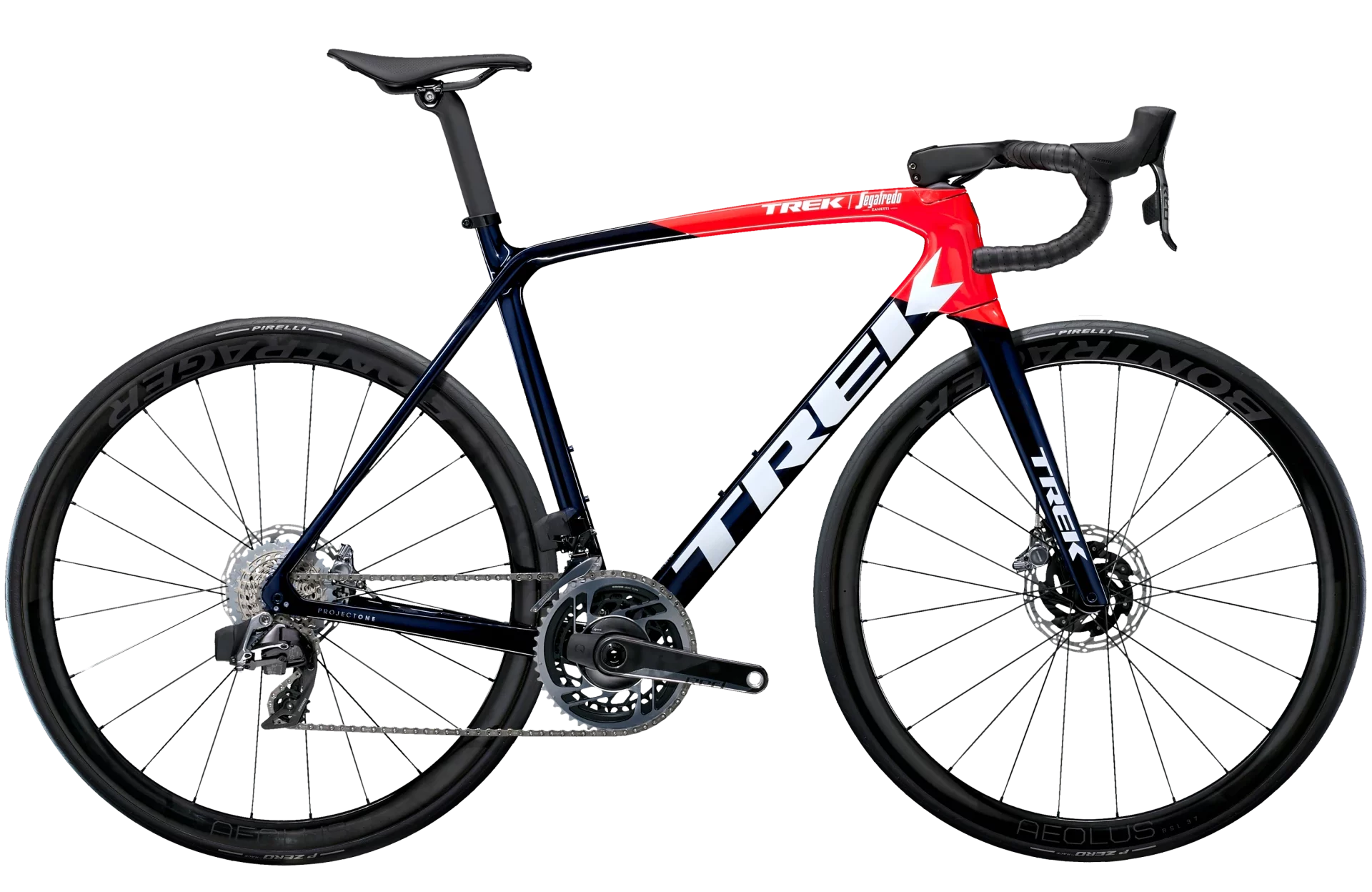
The Trek Emonda is a lightweight bike for the high mountains.
The lightest Trek Emonda frame weighs less than 700g using Trek’s OCLV 800 carbon. This is the bike Richie Porte rode to his third place in the 2020 Tour de France.
The SLR is the lightest and most expensive atop the Trek Emonda models. There are six Emonda SLR options, specced electronic shifting groupsets from SRAM or Shimano.
Next in line is the SL, the mid-range, more budget-friendly option. It has the same frame design and geometry as the SLR but uses the OCLV 500 carbon instead. The groupset choices are Shimano Ultegra Di2 , Shimano 105 Di2 , SRAM Force AXS , or SRAM Rival AXS .
The Trek Emonda SLR and SL framesets are also available separately.
Trek Emonda vs others
2024 Canyon Ultimate vs Trek Emonda
2024 Orbea Orca vs Trek Emonda
2024 Pinarello Dogma F vs Trek Emonda
2024 Pinarello F vs Trek Emonda
2024 Scott Addict RC vs Trek Emonda
2024 Specialized Aethos vs Trek Emonda
2024 Specialized Tarmac SL7 vs Trek Emonda
2024 Specialized Tarmac SL8 vs Trek Emonda
2024 Trek Emonda vs BMC Teammachine SLR
2024 Trek Emonda vs Cannondale SuperSix Evo
Trek Madone
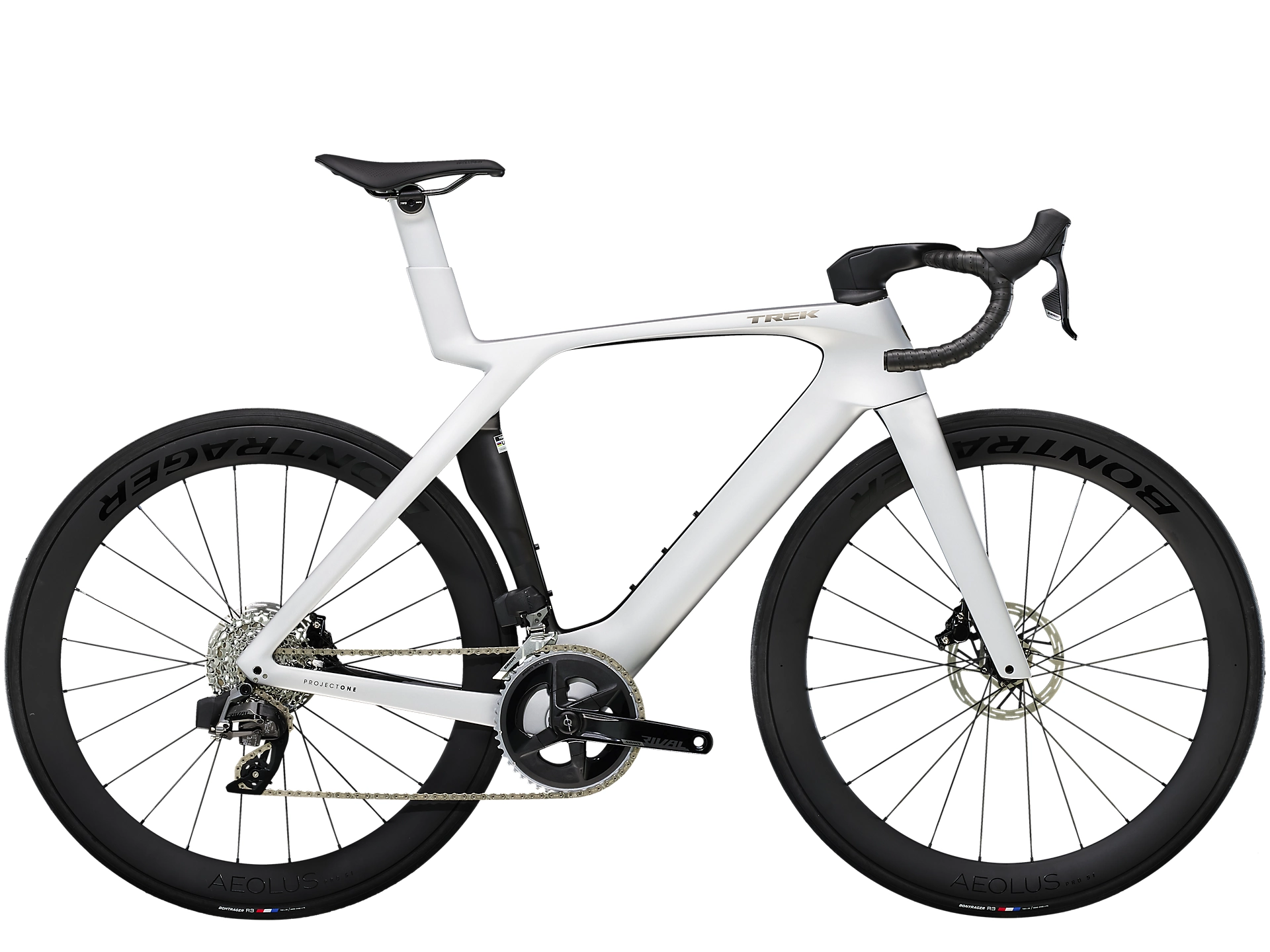
Dubbed the ultimate superbike, the Trek Madone is all about maximizing aerodynamics and speed .
Trek refreshed the Madone in June 2022, just before the Tour de France started. The new Trek Madone features a radical-looking seat tube with a big hole. The previous IsoSpeed system, which allows the seatpost to flex for extra comfort, is replaced by the IsoFlow Technology. According to Trek, the IsoFlow technology adds an aerodynamic advantage, reduces weight, and smooths the road ahead.
The range-topping Madone SLR is built on the Trek’s lightest OCLV 800 carbon, with a one-piece carbon handlebar. The Madone SL models are still based on the previous Madone frame design and use the OCLV 500 carbon.
The Madone SLR frameset is also available separately.
Trek Madone vs others
2024 BMC Timemachine Road vs Trek Madone
2024 Canyon Aeroad vs Trek Madone
2024 Cervelo S5 vs Trek Madone
2024 Giant Propel Advanced vs Trek Madone
2024 Orbea Orca Aero vs Trek Madone
2024 Pinarello Dogma F vs Trek Madone
2024 Scott Foil RC vs Trek Madone
Trek Domane
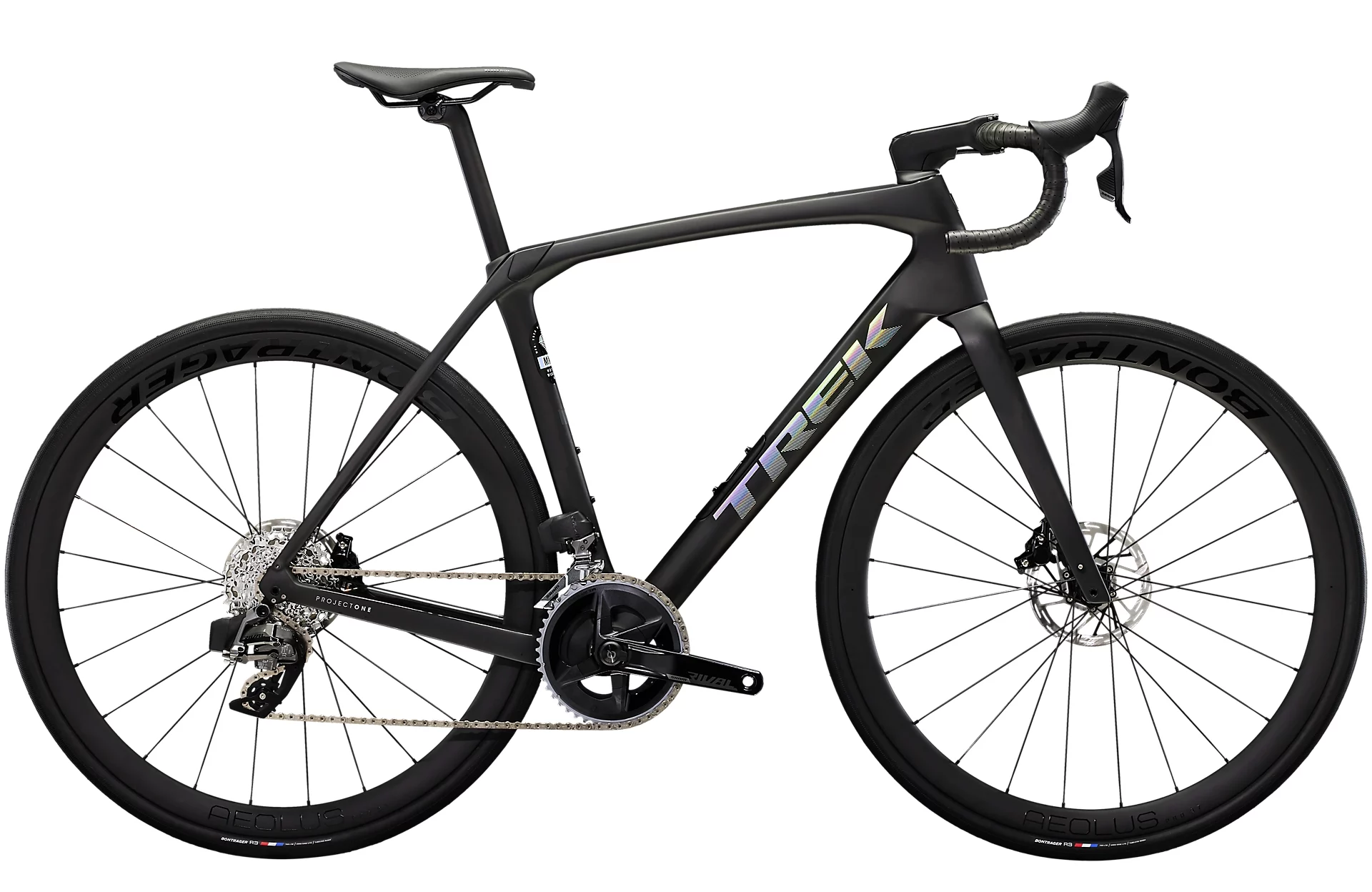
The Trek Domane is designed as an all-day endurance bike .
It can also be referred to as all-road as its wider tire clearance of up to 38c can tackle hard-packed gravel and cobblestones like those in the Paris-Roubaix race . Trek built the Isospeed dampening system in the front and rear to achieve this.
There are carbon and aluminum versions of the Domane. The SLR uses the higher grade, OCLV 800 carbon compared to the SL on the standard, OCLV 500 carbon.
The Trek Domane SL and SLR frames are also available separately for those after a custom-built bike.
Trek Domane vs others
2024 Canyon Endurace vs Trek Domane
2024 Pinarello X vs Trek Domane
2024 Specialized Roubaix vs Trek Domane
2024 Trek Domane vs BMC Roadmachine
2024 Trek Domane vs Cannondale Synapse
2024 Trek Domane vs Cervelo Caledonia
2024 Trek Domane vs Giant Defy Advanced
Trek bikes FAQ
What is the difference between OCLV 500 vs 800 carbon?
The OCLV (Optimum Compaction, Low Void) carbon is a proprietary carbon fiber manufacturing technology developed by Trek. It’s available in OCLV 500 and 800.
- OCLV 500 is a lower-grade carbon but still offers a high level of performance. It has a slightly lower carbon modulus, meaning it’s a bit less stiff and heavier than OCLV 800. OCLV 500 is used in all models with SL .
- OCLV 800 is the highest-grade carbon fiber used by Trek. The carbon modulus is higher, making it stiffer and lighter. The manufacturing process is more refined, using more advanced carbon and resins, leading to a bike frame that provides top performance levels for stiffness, weight, and strength. OCLV 800 is used in all models with SLR .
It’s worth noting that the different OCLV grades don’t only refer to the material itself but also to the manufacturing techniques used to form the carbon fiber into bike frames. Higher-grade carbon requires more precise manufacturing techniques to take full advantage of its superior material properties.
What is the difference between Trek Emonda and Madone?
The Trek Emonda is designed for climbers and all-around riders who want a lightweight, responsive bike with more traditional geometry. In contrast, the Trek Madone is an aerodynamic race machine built for speed and aggressive riding on flat and rolling terrain.
What is the difference between Trek Emonda and Domane?
The Trek Emonda is designed for climbers and all-around riders who want a lightweight, responsive bike with more traditional geometry.
The Trek Domane is an endurance-focused bike built for comfort on long rides and rougher surfaces, such as cobblestones or poorly maintained roads.
What is the difference between Trek Madone and Domane?
The Trek Madone is an aerodynamic race machine built for speed and aggressive riding on flat and rolling terrain. In contrast, the Trek Domane is an endurance-focused bike designed for comfort on long rides and rougher surfaces, such as cobblestones or poorly maintained roads.
How long is Trek’s warranty?
All Trek bikes come with a lifetime warranty for the frame and fork . This is only applicable to the first owner. Second and subsequent owners are entitled to a 3-year warranty from the initial purchase date.
More about Trek’s warranty policy .
Does Trek have women-specific models?
Trek addresses the women-specific models by having frame sizes as small as 44 for riders between 4’ 11” to 5’ (150 to 153 cm).
These smaller bikes have several modifications, such as shorter crankarms, compact cranksets, shorter stems, narrower handlebars, shorter reach brake levers, and women-specific saddles.
What is the difference between Trek’s H1 and H2 geometry?
The H1 and H2 refer to the frame geometry . Most Trek Emonda and Madone have an H2 geometry known as the traditional fit.
H1 is a racing geometry with the head tube 30mm shorter to achieve a lower and more aggressive position on the bike. Most professional cyclists ride the H1 geometry.
What is Project One?
Project One allows you to customize every detail of your dream bike, from colors to components . You can design it through Trek’s website or a Trek-authorized retailer. Bikes available under Project One are the Domane, Emonda, Madone, and Speed Concept (TT).
Are Trek bikes still made in the USA?
As of December 2017, Trek no longer makes any bikes in their Waterloo and Whitewater facilities in Wisconsin. Before that, they used to make around 20,000 of their high-end bikes (SLR models) yearly there. They are made in Asia and sent to Wisconsin for painting and final assembly.
Which professional cycling team ride Trek bikes?
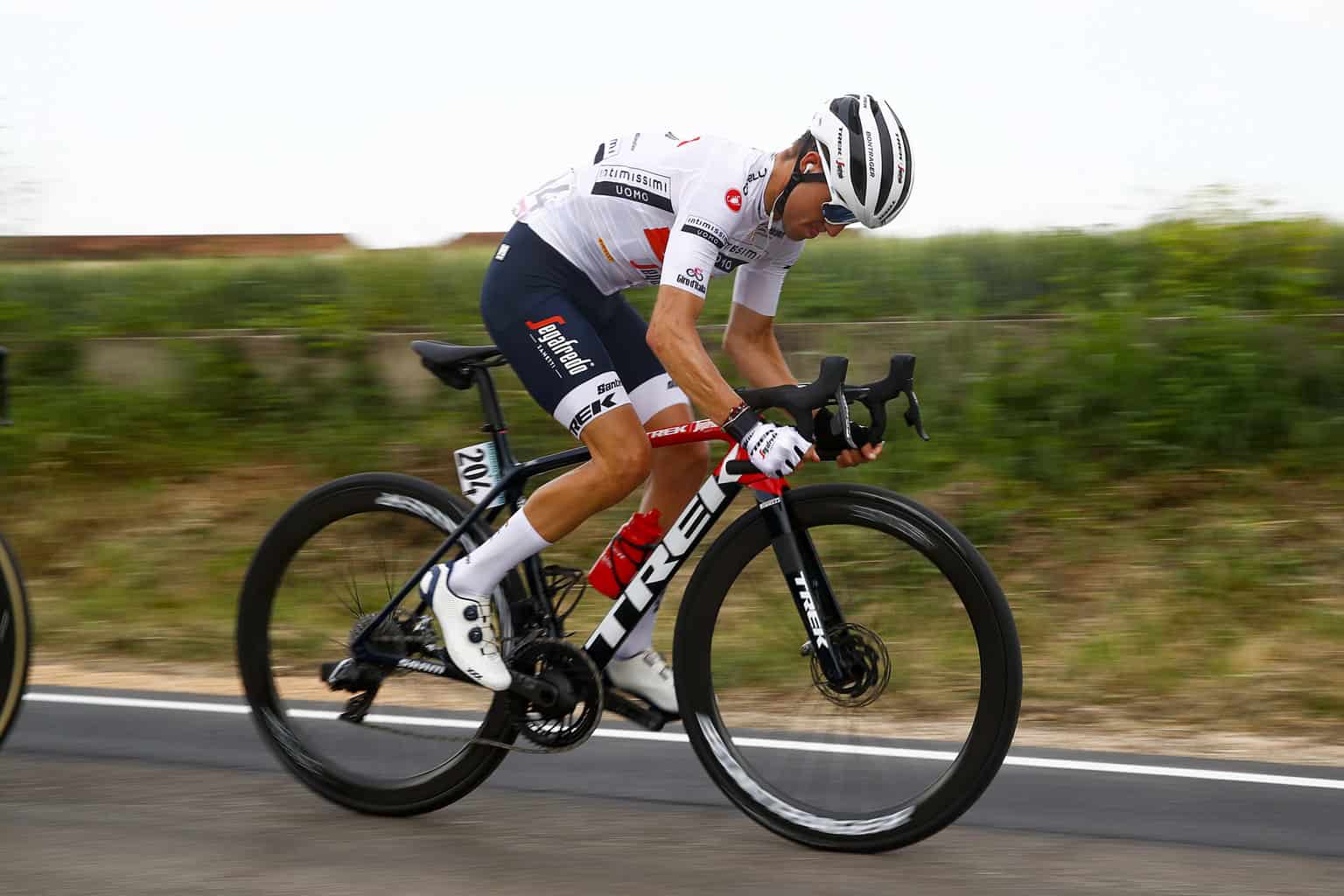
Today, Trek sponsors its own World Tour team, Trek-Segafredo . The team has men’s and women’s pro teams under the same name. Today riders such as multiple Grand Tour winner Vincenzo Nibali, and former men and women road race world champions , Mads Pederson and Lizzie Deignan currently race on a Trek bike.
In the past, several high-profile riders, such as Fabian Cancellara and Alberto Contador, have ridden Trek bikes during the later stages of their career.

Alex Lee is the founder and editor-at-large of Mr. Mamil. Coming from a professional engineering background, he breaks down technical cycling nuances into an easy-to-understand and digestible format here.
He has been riding road bikes actively for the past 12 years and started racing competitively in the senior category during the summer recently.
Mr. Mamil's content is for educational and entertainment purposes only. The content is not a substitute for official or professional advice. Please do your own due diligence.
Mr. Mamil participates in the Amazon Services LLC Associates Program, an affiliate advertising program designed to provide a means for us to earn fees by linking to Amazon.com and affiliated sites. We also participate in various other affiliate programs, and at times we earn a commission through purchases made through links on this website.
Privacy Policy
Website Terms
© Mr. Mamil, 2023

- X (Twitter)
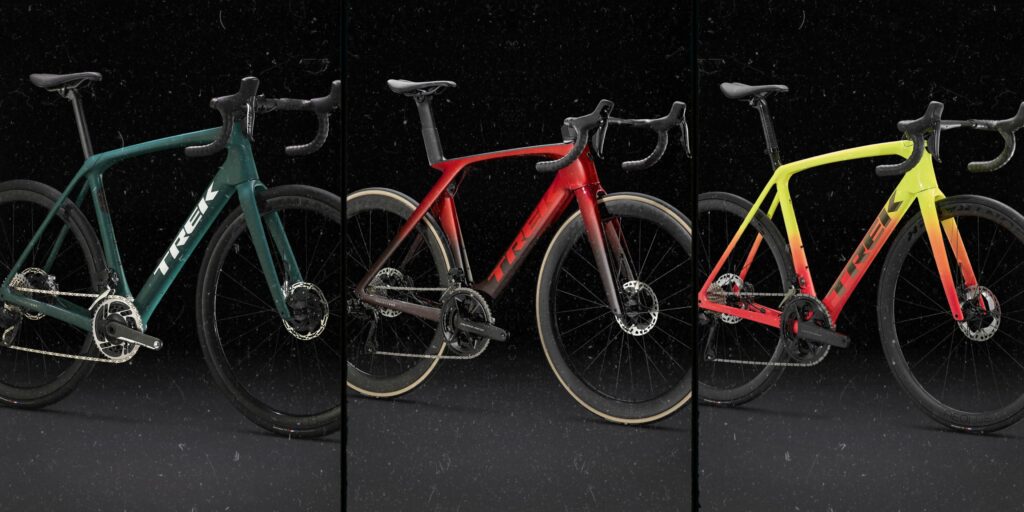
Emonda, Domane or Madone: Which Trek Road Bike Is Best For You?
Trek’s road bike line-up offers everything from the super-fast to the ultra-light to the comfortable endurance machine. At the core of the range are Madone, the one that’s built for speed; Domane, which offers a smoother ride; and Émonda, the lightweight model that’s perfect for ascents. In this blog, we’ll compare these three exceptional bikes so you can decide which one is right for you.
Trek Domane
The Trek Domane is designed for endurance riders who are looking for a comfortable and stable ride, without sacrificing speed. This was the bike that won the women’s Paris-Roubaix in 2022 when the latest iteration was released so you know it’s built to gobble up the cobbles. Domane features Trek’s innovative IsoSpeed decoupler technology, which isolates the seat tube from the rest of the frame, providing a smoother ride, soaking up the bumps and reducing fatigue. It also has wider tyre clearance and a longer wheelbase, which adds to the overall stability of the bike. The Domane is an excellent choice for riders who enjoy long-distance rides or those who want a comfortable bike for daily commuting. The range is available with carbon and aluminium frames and there’s also the Domane+ e-bike range if you’d like that extra assist of an e-bike.
Prices range from £850 for the Domane AL 2 to £13,400 for the Domane SLR 9 AXS Gen 4.

Trek Émonda
The Trek Émonda is a lightweight and responsive bike designed for riders who are looking for speed, performance and outstanding climbing ability. The Émonda ALR is Trek’s lightest aluminium bike but if you’re really looking for weight savings, we recommend the SL and SLR, with the 500 Series OCLV Carbon and 800 Series OCLV Carbon frames, respectively. The latter is crazy light, at less than 700 grams! Émonda also has a more aggressive geometry, which puts the rider in a more aerodynamic position, and the frame itself benefits from aero styling, which all helps to minimise drag. The Émonda is a great choice for riders who want a fast and responsive bike with balanced ride quality and superior handling for racing or for climbing steep hills.
Prices range from £1,750 for the Émonda ALR 4 to £12,950 for the Émonda SLR 9 AXS.

Trek Madone
The Madone is Trek’s top-of-the-line aero bike designed for serious racers and riders who want the ultimate speed and performance. The new Madone made some serious waves in the industry when it was unveiled, featuring Trek’s Kammtail Virtual Foil tube design, which reduces drag and increases speed. The feature grabbing most of the headlines, however, was the IsoFlow seat tube design which essentially has a hole where most bikes have the tube, offering weight savings, aero benefits and similar ride-smoothing benefits as IsoSpeed. Madone has a more aggressive geometry than the Domane and is our pick for riders who prioritise pure speed and performance.
Prices range from £4,800 for the Madone SL 6 to £12,950 for the Madone SLR 9 AXS Gen 7.

All three bikes have their own strengths, and the choice ultimately depends on the type of riding you want to do. If you’re an endurance rider looking for a comfortable and stable bike, the Trek Domane is the one for you. If you want a lightweight and responsive bike for racing or climbing, the Trek Emonda is a great option. And if you’re a serious racer or someone who wants the ultimate speed and performance, we highly recommend Trek Madone.
If you’re looking for a new road bike and need advice on which is best for you, visit us in store and speak to our expert team who’ll talk you through the benefits of each bike and the various specs on offer. Remember, we make buying a bike more affordable by offering 0% finance through Klarna, part exchange and access to a number of cycle to work schemes. Read more in this blog: https://www.flammerouge.cc/new…
Related Posts

E-bikes – join the riding revolution!
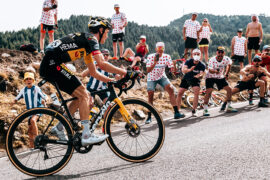
Cervelo R5: The Choice of Champions
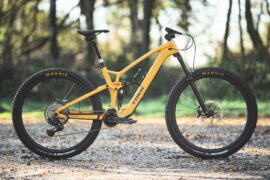
It’s A Revelation! Our Review Of Trek’s Game-Changing Fuel EXe
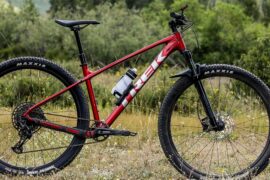
SAVE BIG ON MARLINS
Write a comment cancel reply.
Save my name, email, and website in this browser for the next time I comment.
- Online Store
Type above and press Enter to search. Press Esc to cancel.
Domane vs Emonda: Which Trek Bike Is Right for You?
When you’re shopping for a bike, you have a lot of options to choose from. You can buy a bike off the rack, or you can purchase one that’s customized to your needs. But which is the best option for you? This guide will compare the two most popular Trek bikes: the Domane and the Emonda. We’ll discuss their features, advantages, and disadvantages and help you determine which one is right for you.
Domane and Emonda Bikes
The Trek Domane and Emonda bikes are both excellent options for cyclists looking for a lightweight, incredibly durable bikes. The Domane is designed with a more aerodynamic frame, making it the perfect choice for riders who want to achieve high speeds. The Emonda, on the other hand, is built for comfort and stability. Both bikes come with Shimano components, so you can be sure they will provide reliable performance.
Overview of the Domane and Emonda Bikes
If you’re in the market for a new mountain bike, there are a few things to consider. One of the most important factors is the riding you plan to do. If you’re mainly going to be touring on hard-packed trails, then a bike like the Domane would be a great choice. For more aggressive riders, the Emonda may be better suited.
In terms of weight and dimensions, both bikes are comparable. The Emonda is taller and has a longer wheelbase than the Domane, but they both share almost identical geometry. That means that no matter which one you choose, you’ll easily tackle virtually any terrain.
One other thing to consider is the price. If you’re on a tight budget, the Emonda may be an ideal option. It costs less than the Domane and still offers all the same features and performance. Conversely, the Domane would be your best bet if money is no object. It’s considerably more expensive than the Emonda but has more bells and whistles, including a higher-quality frame and fork.
Define the Domane and Emonda Bikes.
The Trek Domane and Emonda are two of the most famous mountain bikes on the market. They’re both high-quality, durable machines that will take you to trails worldwide. But which one is right for you?
These bikes are built for serious cyclists. They’re not for beginners or people who are new to mountain biking. If you need help riding a bike, don’t buy a Domane or Emonda.
On the other hand, if you’re an experienced cyclist who knows what you’re doing and is looking for a challenging trail ride, then the Domane and Emonda are the perfect bikes for you.
Each bike has unique features that make it better suited for different types of riders. The Domane is faster and more aggressive than the Emonda, but the latter can handle rougher terrain better.
If you want a versatile bike that can do it all, then go with the Domane. It’s faster, more powerful, and easier to control than the Emonda.”
Features That Both Bikes Have In Common
Both bikes have a frame made of aluminum and come with Shimano components. The Domane also has an electronic drive system, while the Emonda does not. Both bikes have a geometry designed to perform well on varied terrain.
The Domane has a longer wheelbase and is more stable than the Emonda, which makes it better for rough roads or long climbs. The Emonda is faster than the Domane but less stable, making it better for racing or flat terrain.
Key Differences Between The Two Bikes
The two bikes that we are comparing are the Domane and the Emonda. The Domane is designed for riders looking for a versatile bike that can handle road and mountain biking. The Emonda, on the other hand, is built specifically for downhill riding and is lighter weight than the Domane.
Here are some key differences between the two bikes:
The Domane has a longer wheelbase than the Emonda, which makes it better suited for long rides.
The Emonda has front and rear suspension, which makes it better suited for downhill riding.
The Domane has a Shimano drivetrain, while the Emonda uses SRAM gears.
The Domane comes with quality tires, while the Emonda comes with wider tires making it better suited for off-road riding.
Features of the Domane Bike
Frame design and materials.
The Trek Domane is a high-end mountain bike that offers a lot of features for cyclists who are looking for the best performance. It has a frameless design and an alloy frame, making it very durable. The Domane also has front and rear suspension, which makes it easy to ride even on rougher terrain.
Trek also uses Shimano components, so you can be sure you’re getting the best possible performance when buying a Domane. Additionally, the bike comes with Shimano hydraulic disc brakes and Tektro mechanical disc brakes, providing excellent stopping power in any situation.
If you’re looking for a top-of-the-line mountain bike that will provide excellent performance, the Trek Domane is worth considering.
Suspension system
The Domane bike suspension system is one of the most advanced on the market. It features a dual-function damper that allows compression and rebound damping, giving you a great range of adjustability. Additionally, the system has an auto-level feature that ensures your ride is always comfortable. The Domane also has several other features, like a water bottle holder and an alloy frame that makes it sturdy.
So if you’re looking for a bike that can handle everything from long rides to quick commutes, the Domane is worth considering.
Brake system
The Domane Bike-Brake system is a standout feature on the Trek Emonda. It’s a mechanical disc brake system with rotors and pads to provide reliable stopping power. The system’s design also allows for easy adjustment and maintenance so that you can stay on the road worry-free.
Other features that make the Trek Emonda a good choice include its lightweight frame, wheels, and comfortable ride. The Emonda is also versatile, with advanced geometry that makes it efficient and stable when cycling in all conditions.
Tire size and compatibility
The Domane is a versatile mountain bike that is perfect for riders who want an XC bike with a bit more downhill ability. The Domane’s 27.5-inch wheel size and 10-speed drivetrain make it an excellent choice for riders who want to mix things up on the trails. The Emonda is another great option if you are looking for a more downhill-oriented mountain bike. It has a longer wheelbase and more aggressive geometry, perfect for technical downhills and rough terrain. Additionally, the Emonda is compatible with 29er wheels, giving you, even more versatility when choosing the right bike for your needs.
Drivetrain components
The Domane Bike-Drivetrain components are both incredibly durable and efficient. The Shimano Deore 11-speed drivetrain provides various gears for varied terrain. The Emonda Rear Hub is also reliable and easy to shift, making it perfect for long rides. The Domane has a powerful Bosch Performance CX motor that provides plenty of power when needed.
Features Of The Emonda Bike
This Trek Emonda bike has a Shimano Deore drivetrain and a Reynolds 853 aluminum frame. It’s available in men’s, women’s, and kids’ sizes.
The bike has an adjustable saddle, disc brakes, and fenders. It is also lightweight and easy to ride. One downside of the bike is that it does not have a back rack or cargo carrier.
The Emonda suspension system is designed to provide a smooth and comfortable ride. It has adjustable shock absorbers, making it possible to fine-tune the suspension for your riding style. The bike also features rider-specific geometry specifically tailored to fit your body. The frame also features internal cable routing, making maintenance and repairs easier.
The Emonda bike-brake system is one of the most advanced available. The system uses electronic sensors to detect when you are braking and then uses an adjustable brake lever to apply the required pressure to the brakes. This eliminates the need for constant adjustments of your brake pads, which can be a hassle if you’re riding in a hurry.
Another feature of the Emonda bike-brake system is its ability to stop your bike when you reach a standstill automatically. This is useful if you want to stop at a red light or if you’re waiting for someone else on a busy road.
The Emonda bike-brake system has several different adjustment settings, so it can be tailored to fit your needs perfectly. You can also use either handbrakes or rim brakes, which allows you to choose whichever type of braking system works best for you.
The Emonda is Trek’s most advanced mountain bike to date. It has several features that set it apart from other mountain bikes on the market. The bike has a carbon fiber frame and fork, making it strong and lightweight. In addition, the bike also has a suspension fork that provides comfort when riding over rough terrain.
In terms of tire size, the Emonda comes with 26-inch tires. This is slightly smaller than other mountain bikes on the market, but it allows for a more nimble ride. Additionally, the bike is compatible with most cycling shoes, so you can put in whatever type of shoe you prefer.
The Emonda bike drivetrain is composed of a Shimano Deore drivetrain with a SRAM Rival 2×10 drivetrain. The Deore and Rival 2×10 drivetrains are equipped with Shimano 105 gears, allowing various gearing options. The Emonda also features an aluminum frame, which provides a lightweight and durable ride.
Domane vs Emonda: Performance Comparison
The two most popular Trek mountain bikes are the Domane 9.9 and the Emonda HB30. Both bikes offer excellent performance, but which one is right for you? To help make the decision, we’ve put them head-to-head in several categories to see which is stronger.
Bike Weight
The Domane 9.9 is significantly heavier than the Emonda HB30, making it better suited for riders who are looking for a more stable ride.
Comfort/Suspension
Both bikes have excellent comfort and suspension, but the Domane 9.9 wins this category due to its heavier weight and greater stability.
Gears/Brakes
The Emonda HB30 has better gears and brakes, making it better suited for downhill riding or technical sections of the trail. However, the Domane 9.9 has a wider range of gears, making climbing hills or traveling farther on long rides easier.
Compare the performance of the Domane and Emonda bikes
If you’re looking for a versatile bike that can take on any terrain, the Domane and Emonda offer different but equally impressive performances.
The Domane is designed for speed and climbing, while the Emonda is designed for comfort and versatility. Both bikes are tough and have plenty of features to make them great long-ride options. However, if you’re looking for a specific type of ride or need more help with stability when riding off-road, the Domane might be a better choice.
Both bikes are available in varying frame sizes, so there’s sure to be one that fits your needs. Additionally, both bikes come equipped with Shimano Di2 groupsets, hydraulic disc brakes, and 9-speed SRAM shifters – making them versatile all-rounders.
Ultimately, it comes down to your type of rider – if you’re focused on speed and climbing abilities, the Domane is perfect if you’re more interested in having an overall comfortable experience while out cycling, the Emonda may be a better option for you.
Discuss the strengths and weaknesses of each bike.
The Trek Domane and Emonda are two of the most popular mountain bikes on the market. Both bikes have strengths and weaknesses, which may affect your decision to purchase one or the other. Here is a closer look at each bike’s strengths and weaknesses.
The Domane and Emonda are very well-built bikes, withstanding much abuse. They’re also easy to ride, making them great options for beginner riders.
Both bikes are capable of reaching high speeds on mountain trails. They’re also stable at high speeds, making them good choices for experienced riders who want an easygoing bike that can handle some fast sections.
Both bikes are comfortable for riding long distances. They’re also relatively lightweight, which makes them manageable on long rides.
Weaknesses:
The Domane is slightly more expensive than the Emonda, which may be a disadvantage for some users. Additionally, the Domane is less versatile than the Emonda when choosing different types of terrain.
Domane vs Emonda: Comfort Comparison
Regarding comfort, there’s no comparison between the two Trek bikes. The Domane is incredibly plush and smooth, while the Emonda is tough and efficient.
The Domane is perfect for riders who want the most comfortable ride possible. It has a softness and suppleness that makes cycling on long rides a pleasure. The Emonda, however, is great for those looking for a bike that can handle lots of climbing and rough terrain. It’s also perfect for downhill riding, delivering powerful acceleration and excellent handling.
Ultimately, it depends on what you’re looking for in a bike. If you’re mainly concerned with comfort, then the Domane will be your best option. However, if you’re looking for something that can handle a lot of tough terrains, the Emonda is the better option.
Compare the comfort of the Domane and Emonda Bikes
The Trek Domane and Emonda models are two of the most popular mountain bikes. They both have a relaxed geometry that makes them comfortable to ride, with a wide range of sizes available to fit a variety of riders.
Both bikes offer great suspension performance, with the Emonda featuring a more updated design. However, the Domane is slightly cheaper and has been praised for its durability. So which one is right for you?
The main difference between the two bikes regards to comfort. The Emonda features a more relaxed geometry that makes it more comfortable to ride than the Domane, which has a more aggressive geometry. Regarding comfort, this decision comes down to personal preference. If you’re looking for an easygoing bike that will make long rides enjoyable, the Emonda is worth considering. On the other hand, if you’re looking for a bike that will provide excellent performance on hills and in technical terrain, the Domane may be better suited for you.
Durability:
Another key difference between these two bikes is durability. The Domane is slightly cheaper and has been praised for its durability by many users. It’s also available in a wider range of sizes than the Emonda to fit a wider range of riders. Whether you’re looking for a dependable bike that will last you years or wants something affordable that won’t let you
Discuss the key factors that contribute to comfort on a bike
Comfort is key on a bike, and several factors can contribute to its overall comfort level. This article compares the two most popular bikes in the Trek lineup: the Domane and the Emonda.
First things first: both bikes come with adjustable geometry. This means you can personalize them to fit your riding style better. However, if you plan on doing a lot of touring or commuting, the Emonda might be a better choice due to its wider handlebars and more padded saddle.
Next, both bikes have Shimano 105 components. This ensures smooth shifting and long-lasting durability. Both bikes also have hydraulic disc brakes, which provide excellent stopping power in all conditions.
The final major factor that contributes to comfort on a bike is weight distribution. The Domane has more weight up front, making it easier to handle in tougher terrain or when carrying heavier loads. However, the Emonda is lighter, which makes it easier to lug around for extended periods. Ultimately, it boils down to what kind of riding you plan on doing and which type of comfort you are most concerned about.
Domane vs Emonda: Price Comparison
If you want to buy a Trek bike, you have two options: the Domane and Emonda. Both bikes are excellent for riders of all levels, but which one is right for you? Here’s a comparison of the two bikes to decide for yourself.
The Domane is built for riders who want high performance and versatility. It has a lightweight aluminum frame that makes it easy to ride, even on long trails. The Emonda is perfect for riders who want comfort and stability. Its heavy-duty carbon fiber frame provides great support and durability, making it the perfect choice for long rides.
Both bikes offer great value for your money, but the Domane might be better suited depending on your needs. If you’re looking for high performance, the Domane is worth considering. However, if you’re more interested in comfort and stability, the Emonda is a better option. Overall, both bikes are excellent choices; there’s no wrong choice if you want to buy a Trek bike.
Compare the prices of the Domane and Emonda Bikes.
The Trek Domane and Emonda bikes are excellent mountain bikes with different features that could make one better suited for your riding needs. The Domane has a more responsive frame and fork, while the Emonda has a more comfortable saddle and durable materials. Both bikes are available in various sizes and colors, so finding the right one is easy.
Here are some key comparisons between the two:
The Domane frame is stiffer and more responsive than the Emonda. This makes it better for fast uphill rides and technical downhill sections.
Suspension:
The Emonda incorporates plush suspension into its design, making it significantly softer than the Domane. This is great for riders who want a more comfortable ride on rough terrain or long rides.
Wheels & Tyres:
The Domane comes with Shimano Deore XT components, providing good gear shifting and durability. The Emonda has a wider range of tire options to choose from, giving you more choices when it comes to how much terrain you want to tackle.
Explain the factors that affect the price of a bike
Many factors affect the price of a bike, such as the type of bike, the brand, and the size. Here are some more specific factors to consider:
Type of Bike
The type of bike you choose will affect its price. For example, a mountain bike is more expensive than a road bike. This is because mountain bikes are designed for off-road use, and road bikes are designed for on-road use.
The brand of the bike also affects its price. Higher-quality brands tend to be more expensive than lower-quality brands. Higher-quality brands have more resources, allowing them to produce better bikes.
Size and Configuration
The size and configuration of the bike also affect its price. For example, a standard mountain bike usually costs less than an adventure or racing bike. This is because standard mountain bikes are designed for general cycling purposes, while adventure and racing bikes are designed for specific uses (such as downhill racing or touring).
Domane vs Emonda: Which One to Choose?
If you’re looking for a versatile bike that can handle plenty of terrains, the Domane and Emonda are two great options. Here’s a look at the key differences between these two models:
The Domane is designed for experienced cyclists who want a bike that can handle long climbs and descents. It has a longer wheelbase than the Emonda, which allows it to stay stable on rougher terrain. The Domane also has hydraulic disc brakes, providing superior stopping power in challenging conditions.
The Emonda is perfect for beginner riders or those who need a more nimble bike for city riding. It has a shorter wheelbase and is lighter than the Domane, making it easier to maneuver in tight spaces. The Emonda also comes with standard Shimano gears, making it easy to pedal up hills or travel long distances.
Key Differences Between Domane and Emonda Bikes
The Domane and Emonda are two of Trek’s most popular mountain bikes. Both bikes have Shimano Di2 electronic shifting and a durable aluminum frame, but they offer different features and specs that make one better suited for your needs.
The Domane is geared more toward experienced riders who want the greatest range of gears and the ability to pedal quickly. It also has a higher price tag than the Emonda, but it has more features, such as a secondary dropper post for adding height on climbs and a wider range of gearing options.
If you’re looking for a bike that will stay comfortable all day, the Emonda is worth considering. It has a softer suspension setting that makes it easy to ride over rough terrain, and its lighter weight makes it easier to carry up hills.
Recommend Domane or Emonda based on different needs and preferences
If you’re looking for a versatile bike that can handle all sorts of terrain, the Domane or Emonda may be a good option. Both bikes have impressive suspension and brakes, making them great choices for serious cyclists.
The Emonda is more expensive than the Domane but has a wider range of gears and a better frame. If you’re looking for an all-around bike that can take on any challenge, the Emonda may be the best choice.
On the other hand, if you prioritize price over features, the Domane may be a better option. It’s cheaper and has comparable performance to the Emonda. So which one is right for you?
Decide what type of cyclist you are before making your decision. Are you interested in tackling mountains or rolling along flat roads? Do you want a bike that is easy to ride or one with superior performance? Once you know your preferences, check out reviews to see which bike is best suited for your needs.
Similar Posts
Is Diamondback A Good Bike: Diamondback Bikes Review
Diamondback is a well-known and respected brand in the cycling industry. They offer a wide range of bikes for different types of riding, including road, mountain, and hybrid bikes. Diamondback bikes are known for their durability and performance, making them a popular choice among cyclists of all levels. In terms of mountain bikes, Diamondback offers…
Age Related Cycling -Average Kids Bicycle Riding Speed
As we all know, cycling is a great way to get exercise and improve our health. It’s also a great way to commute to work or school! But if you’re like most people, you don’t know how fast you should be cycling according to your age. That’s why we put together this age chart to…
Hiland Mountain Bike Reviews – 2023 Buyer’s Guide
Welcome to our Hiland mountain bike review and buyer’s guide for 2023! Hiland is a well-respected brand in the mountain biking industry, known for producing high-quality and reliable bikes. In this guide, we will be taking an in-depth look at some of the best mountain bikes that Hiland has to offer, highlighting their key features…
How Fast Do Dirt Bikes Go? (10 Dirt Bike Speed Explanation!)
Dirt bikes are a popular form of off-road motorcycle that is designed for use on rough terrain, such as dirt, gravel, mud, and sand. They are typically lightweight, with high-performance engines and long-travel suspension, making them well-suited for motocross and other off-road racing. One of the key features of a dirt bike is its speed,…
Look into Electric Bikes: Are E-Bikes Safe for Seniors?2023
E-bikes, or electric bicycles, have become increasingly popular in recent years due to their convenience and ability to make cycling more accessible for people of all ages and abilities. Many seniors are considering e-bikes as a form of transportation or leisure activity, but may have concerns about their safety. It is important for seniors to…
3 Reasons Why You Need To Consider Timber trail Electric Bikes
If you’re like most people, you probably think of bicycles as simple machines that you use to get around town. But in reality, there are a dizzying variety of different types of bicycles out there, each with its own unique features and benefits. If you’re in the market for a new bicycle, and you’re not…
Leave a Reply Cancel reply
Your email address will not be published. Required fields are marked *
Save my name, email, and website in this browser for the next time I comment.
Cookies on this website
We use cookies to make our website work properly. We'd also like your consent to use analytics cookies to collect anonymous data such as the number of visitors to the site and most popular pages.
I'm OK with analytics cookies
Don't use analytics cookies
Which Trek Road Bike Should I Get? Madone, Emonda or Domane?
Trek’s road bike range has everything covered, whether you’re looking for outright speed, a lightweight climber or comfort and endurance. If you’re thinking of upgrading or expanding your road line-up, read on to find out whether Madone, Émonda or Domane is the right bike for you.
Trek Madone: Fast and Aero

The Madone is Trek’s most aerodynamic road bike. It’s built for serious racers and riders who want the ultimate in speed and performance on the flat and more rolling routes. Madone is great for time trials, circuit and road racing or just going out for a blast on your favourite road.
The new generation Madone made waves when it was unveiled last year, with the IsoFlow seat tube design attracting a lot of attention. This feature puts a diamond-shaped hole where bikes would normally have the tube, offering aero benefits, weight savings and similar ride-smoothing benefits as the IsoSpeed decoupling technology. Trek Madone has a more aggressive geometry than the Domane, meaning it is a bit lower and longer at the front of the bike, putting you in a more aero position so it cuts through the wind and allows you to carry far more speed. Madone is our pick for riders who prioritise pure speed and performance over comfort and climbing. Prices for the latest ‘gen 7’ Madone range from £10,200 for the Madone SLR 7 which comes with electronic 2 x 12 Shimano Ultegra Di2 drivetrain and Bontrager Aeolus Pro 51 carbon wheels (see photo) all the way up to £14,500 for the incredible Madone SLR 9 AXS. However, it is still possible to snap up bikes from previous generations for less, including the Madone SL 6, which is available in our sale at £4,250.
Trek Émonda: Nimble and Lightweight

The Trek Émonda is a nimble lightweight bike, designed for quick response and for outstanding performance on the climbs. The Émonda ALR is Trek’s lightest aluminium bike, but if you’re really looking for weight savings, it’s got to be an SL or SLR model, with the 500 Series OCLV Carbon and 800 Series OCLV Carbon frames, respectively. Both are light but the 800 Series is incredible, weighing in at less than 700 grams. Like the Madone, Émonda’s geometry puts the rider in a more aerodynamic position and the frame features aero styling too, all helping to minimise drag. The Émonda is a great choice for riders wanting a race bike that climbs brilliantly and is responsive around corners.
The Émonda ALR 5 Disc which is currently on sale at £1,980 features a great spec for the price and is perfect if you’re looking to get into racing.
The range tops out at the Émonda SLR 9 AXS at £12,950, which features the 800 Series OCLV Carbon frame, ultra-light Aeolus RSL 37 wheels and SRAM’s highest level RED AXS wireless electronic drivetrain. We think the Émonda SL 6 Pro Di2 is an excellent mid-range pick at £4,625.
Trek Domane: Comfortable and Versatile

The new Trek Domane is the bike for those who want to stay comfortable for longer road rides. When it was released, the latest generation Domane won the women’s 2022 Paris-Roubaix, one of the toughest and roughest terrains you will ever see a racer ride on, with over 90 miles of battering cobbles on the route, so it definitely has what it takes to compete.
Domane features Trek’s innovative IsoSpeed decoupler technology, which isolates the seat tube from the rest of the frame, soaking up the bumps, reducing fatigue and delivering an altogether smoother experience. It also has wider tyre clearance so you can run tyres up to 38c, depending on whether you’re sticking to the roads, taking on varied terrain or heading out on light gravel, which the Domane eats up easily.
This is the perfect bike for riders who are looking for slacker, more upright, stable geometry which is ideal for tourers and weekend explorers, wanting a more comfortable bike. The entry point to the Domane range is the AL 2 at £975, which is an excellent first step into the world of comfortable day-long riding, and it extends to the SLR 9 eTap at £13,400, the official Trek-Segafredo race team replica bike. We are big fans of the new generation Domane SL 6 , that comes with 500 Series OCLV Carbon frame, rear IsoSpeed, powerful flat-mount disc brakes and 2 x12 Shimano 105 Di2 wireless electronic drivetrain which is priced at £4,800 .
Which Trek road bike is for you?
Madone, Émonda and Domane are all excellent bikes, with their own strengths. Deciding which one is best for you obviously comes down to what kind of riding you plan to do. If you want the fastest, most aero road bike possible, then the Madone is a great choice.
The Émonda is another bike that’s favoured by people who want speed but the geometry better suits steeper climbs. Emonda is a great all-rounder for a lightweight bike for weekend racing and week-time club rides.
The Domane is the one for you if you want a road bike that’s still swift but also comfortable for longer days in the saddle and on rougher terrain.
Come in and speak to our expert team if you need advice on which model and size is right for you. We have dedicated roadies in our team who would love to help.
You can also ‘try before you buy’ with a test ride in our car park. Remember, we make buying a bike more affordable by offering 0% finance and access to a number of Cycle to Work schemes. Give us a call us on 0121 745 2618 or book a personal bike consultation with one of the team.

Trek Madone Vs Domane Road Bikes (8 Key Differences!)
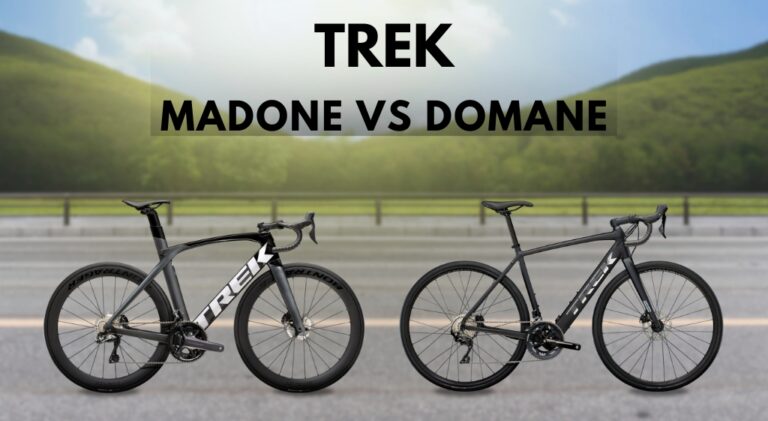
Trek Madone and Domane road bikes are two great options for anyone in the market for a new road bike. Both Madone and Domane offer a great selection of road bikes, each with its unique features and benefits.
Trek Domane Road Bike is Trek’s endurance road bike. It has been designed to provide a comfortable, smooth, and efficient ride for long distances.
Trek Madone is Trek’s flagship road bike. It has been designed for speed and performance, making it the perfect choice for riders who want to push themselves on the roads.
Trek Madone Vs Domane Road Bikes
The main difference between Trek Madone and Domane road bikes is that Trek Madone is a racing bike while Domane is built for endurance.
The biggest difference between the two bikes is that the Trek Madone has a more aggressive riding position while the Domane has a more comfortable riding position.
Trek Madone Overview: Who Should Get Madone?
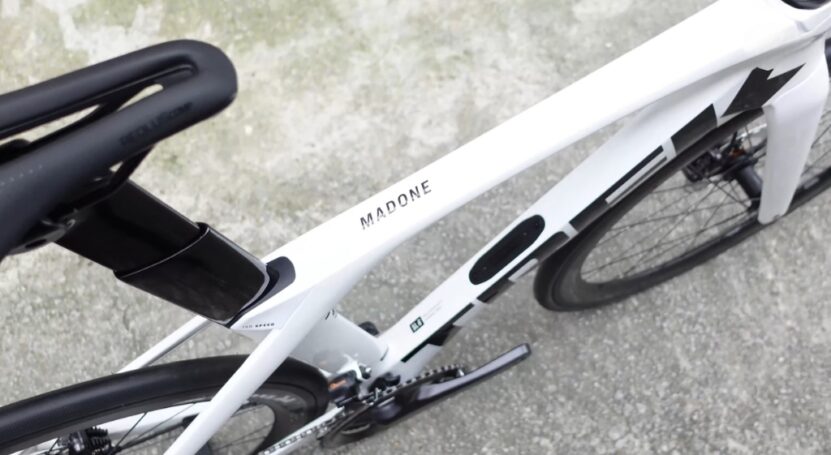
The Trek Madone is Trek’s top-of-the-line race bike. It has been designed to be the fastest road bike that Trek has ever created. The Madone is perfect for anyone who wants to get the most out of their riding, whether that means competing in races or simply riding as fast as they can.
The Trek Madone has been created with input from some of the world’s top riders, including multiple Tour de France winner Alberto Contador . Trek has used the latest technology and materials to create a bike that is extremely fast and efficient.
If you are looking for a bike that will help you to achieve your fastest times, the Trek Madone is a perfect choice.
Trek Domane Overview: Who Should Get Domane?
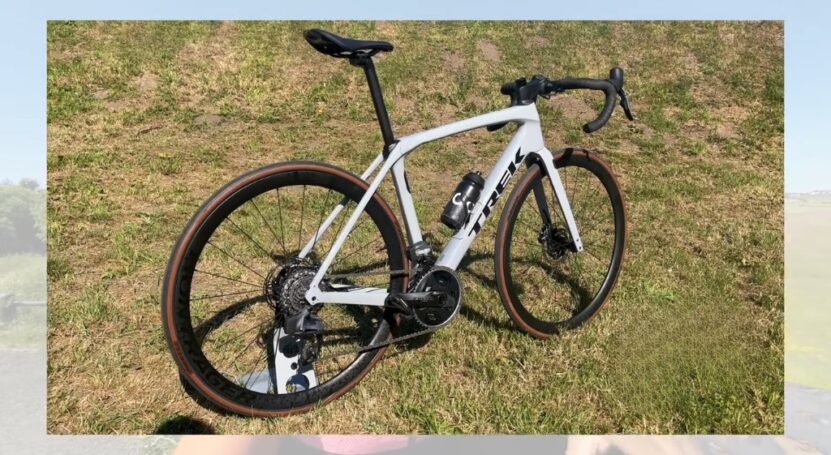
The Trek Domane is Trek’s endurance road bike. It has been designed to be comfortable and efficient, making it perfect for anyone who wants to ride long distances.
The Trek Domane has been created with input from some of the world’s top riders, including three-time Paris-Roubaix winner Fabian Cancellara. Trek has used the latest technology and materials to create a bike that is extremely comfortable and efficient.
If you’re looking for a road bike that can handle long rides, then the Trek Domane is the bike for you.
Trek Domane Vs Madone Detailed Comparison
Let’s look at some of the distinctions between the Madone and Domane road bikes.
The Trek Madone is a race bike, designed for speed and efficiency. The Trek Domane is an endurance road bike, designed for comfort and distance.
A race bike is typically lighter and has a more aggressive geometry, which means that it is designed for faster riding. An endurance road bike is heavier and has a more relaxed geometry, which makes it better suited for longer rides.
The Trek Madone is designed for the rider who wants to go fast. The Trek Domane is designed for the rider who wants to ride comfortably and distance.
The Trek Madone is focused on speed, while the Trek Domane is focused on comfort and distance.
Trek Madone vs Domane Geometry
The Trek Madone has a more aggressive geometry than the Trek Domane. This means that it is designed for faster riding and is not as comfortable for long rides.
The Trek Madone has a shorter wheelbase and steeper head tube angle than the Trek Domane. The Trek Domane has a longer wheelbase and shallow head tube angle , which makes it more stable and comfortable for long rides.
The Trek Madone has no suspension, while the Trek Domane has Trek’s IsoSpeed decoupler technology, which provides up to 20mm of travel
The Trek Madone is designed for speed and efficiency and does not need suspension. The Trek Domane is designed for comfort and distance and has suspension to help smooth out the ride.
Preferred Terrain
The Trek Madone is designed for smooth roads and racing. The Trek Domane is designed for rough roads and long rides.
The Trek Madone performs best on smooth roads and is not as comfortable on rougher terrain. The Trek Domane is more comfortable on rough roads and can handle long rides better.
Bike Weight
The Trek Madone weighs approximately 7.37 kg, while the Trek Domane weighs approximately 8.3 kg.
The Trek Madone is lighter than the Trek Domane, which makes it faster and easier to ride. The Trek Domane is heavier than the Trek Madone, which makes it more comfortable for long rides.
The Trek Madone is designed for speed and is one of the fastest road bikes on the market. The Trek Domane is designed for comfort and distance and is not as fast as the Trek Madone.
The Trek Madone is faster than the Trek Domane because it is lighter and has a more aggressive geometry. The Trek Domane is not as fast as the Trek Madone because it is heavier and has a more relaxed geometry.
Trek Madone vs Trek Domane: 8 Key Differences
The Trek Madone has been designed for speed and performance, while the Trek Domane has been designed for comfort and endurance.
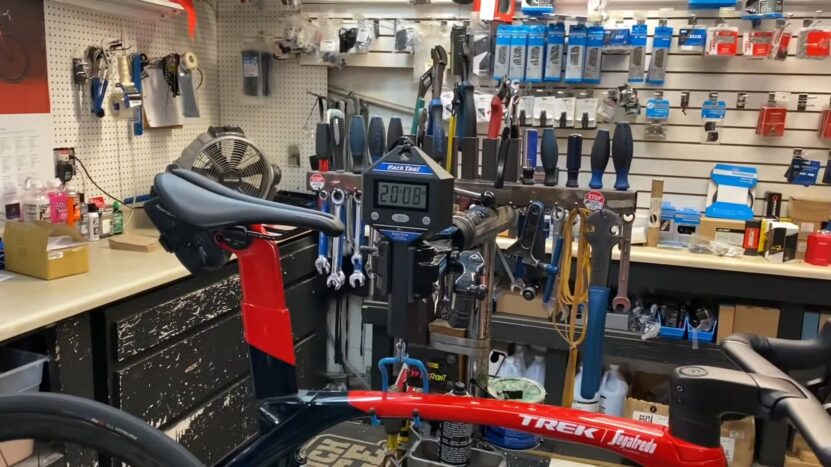
The Trek Madone is lighter than the Trek Domane.
The Trek Madone has race-inspired geometry, while the Trek Domane has endurance-inspired geometry.
The Trek Madone has no suspension, while the Trek Domane has Trek’s patented IsoSpeed decoupler for a smoother ride.
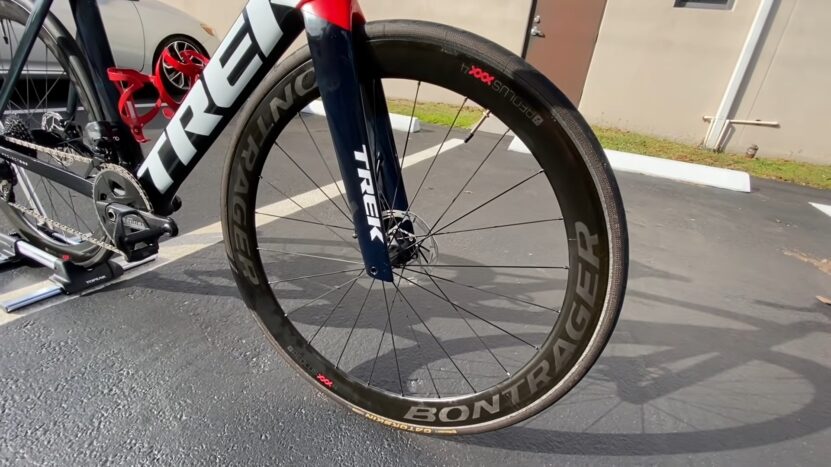
The Trek Madone comes with 23c tires, while the Trek Domane comes with 28c tires.
The Trek Madone has Shimano Dura-Ace brakes, while the Trek Domane has Trek’s custom Bontrager Paradigm brakes.
Bottom Bracket
The Trek Madone uses a press-fit BB90 bottom bracket , while the Trek Domane uses a threaded BB86 bottom bracket.
The Trek Madone has an integrated seatpost, while the Trek Domane has a standard seatpost.
Trek Madone vs Trek Domane Models
Madone family.
The two models of the Madone family are the Madone SL and the more recently released, flagship-level model, the Madone SLR.
Trek’s top-of-the-line race bike, the Trek Madone SLR is a dream come true for any rider looking for an edge on the competition.
Domane Family
The Trek Domane comes in six models: the Trek Domane 4.5, Trek Domane 5.2, Trek Domane 6.2, Trek Domane SL 6.9, Trek Domane S 6.9 and the Trek Domane Project One.
The Trek Domane 4.5 is the most affordable model and is perfect for entry-level riders or those on a budget. The Trek Domane 5.2 is a great option for anyone looking for a versatile bike that can handle a variety of terrain.
Trek Madone Vs Domane Similarities
1. Both have Trek’s race-proven geometry and IsoSpeed technology.
2. The Trek Madone and Domane are both built to be fast, efficient road bikes.
3. Both bikes come in a variety of frame sizes to fit riders of all heights.
4. Trek’sMadone and Domane both have impressive component specs.
5. The Trek Madone and Domane are both designed for long rides and Gran Fondos.
6. They both come with a lifetime warranty on the frame.
Trek Madone SLR9 Vs Domane SLR9 Compared.
Here are some Factors to compare the Trek Madone SLR9 vs Trek Domane SLR9:
The Trek Madone SLR9 is a road bike while the Trek Domane SLR9 is a gravel bike.
The Trek Madone SLR9 has an OCLV carbon frame while the Trek Domane SLR9 has an OCLV carbon frame with an IsoSpeed decoupler.
The Trek Madone SLR9 has no suspension while the Trek Domane SLR9 has Trek’s patented IsoSpeed decoupler for a smoother ride.
The Trek Madone SLR9 comes with 23c tires, while the Trek Domane SLR9 comes with 28c tires.
The Trek Madone SLR9 has a Shimano Dura-Ace Di2 drivetrain, while the Trek Domane SLR9 has a SRAM RED eTap AXS drivetrain.
The Trek Madone SLR9 is more expensive than the Trek Domane SLR9
The Trek Madone SLR 9 is the fastest, most aerodynamic road bike that Trek has ever made. It’s built for speed and performance, and it shows in every aspect of the bike. From the OCLV carbon frame to the Shimano Dura-Ace Di2 drivetrain, this bike is designed to win races.
Is The Trek Madone An Endurance Bike?
The Trek Madone is an endurance bike that can be ridden for long distances without too much strain on the body. It is perfect for riders who want to cover a lot of ground in a single ride, or those who are training for a longer event.
The frame is made from lightweight materials and has been designed to provide a comfortable, stable ride. The Madone also comes with a variety of gearing options, so you can choose the perfect setup for your needs.
A bike that can take you from your local group ride to an endurance event, the Trek Madone is a great choice.
Is Trek Madone Comfortable?
Yes, Trek Madone is very comfortable. The saddle and handlebars are adjustable, so you can customize them to fit your body perfectly.
Plus, the frame is designed to absorb shocks and vibrations, so you can ride for hours without feeling uncomfortable. For a high-performance road bike that is also comfortable to ride, Trek Madone is a great choice.
Is Trek Domane Fast?
Trek Domane bikes are known for being fast and efficient. They’re perfect for riders who want to cover a lot of ground quickly, without feeling like they’re working too hard.
For a high-performance bike that will make every ride feel exhilarating, the Trek Domane is definitely worth considering.
With its lightweight frame and quick-rolling wheels, the Domane is perfect for races, centuries, and all-day rides. So if you’re looking to go fast, the Trek Domane is definitely the bike for you.
Is The Trek Domane A Gravel Bike?
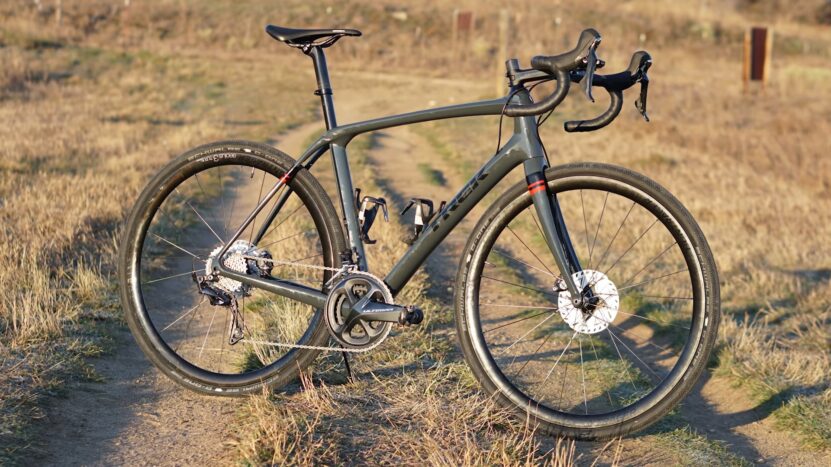
Trek Domane is an excellent bike for gravel rides and centuries. The Domane has endurance geometry which puts the rider in a more comfortable position, allowing you to ride farther. The frame is also designed to dampen vibration, making for a smoother ride.
Additionally, the Domane has clearance for wider tires, which provide more traction on loose surfaces. If you’re looking for an all-around bike that can handle a variety of terrain, the Trek Domane is a great option.
In the end, Trek Madone is a better road bike for someone who wants to focus on speed and performance, while Trek Domane is better suited for someone who wants a more comfortable ride.
Trek Madone is also lighter and has a more aggressive geometry, making it faster and easier to ride. Trek Domane, on the other hand, is heavier and has a more relaxed geometry, making it more comfortable for long rides.
Related Posts:
- Trek Emonda vs Trek Domane (Detailed 5 Technical Comparison)
- Trek Domane Sl5 vs Sl6 (9 Comprehensive Differences)
- Trek Fx vs Domane (7 Helpful Differences)
- Madone Vs Aeroad (7 Helpful Differences)
- Madone vs Tarmac
- Titanium Road Bike (5 Cool Road Bikes)
+33 3 90 46 19 52
We have saved your search. Check your e-mail regularly for our suggestions. See you soon!
In this Article
Choosing between the trek emonda and the trek domane..
Published on January 4, 2023
The Trek road bike range consists of three models (which amusingly are anagrams of each other 😉): Madone, Domane, and Emonda . The Trek Madone is the brand's aero star bike. In its recent versions, it features IsoFlow technology, a surprising cavity under the seat tube intended to improve aerodynamic penetration. On the other hand, Domane and Emonda are much closer to each other. They are more comfortable and versatile than the Madone , but each has its own specialty. What are the differences between the Trek Emonda and the Trek Madone? In this article, we will tell you everything about these two models to help you choose the one that suits you.
Comfort and Endurance: Trek Domane Advantage
The Domane is clearly THE endurance bike from the Trek brand. With this bike, the motto is clear: comfort, enjoyment, and long rides!
This characteristic is mainly due to the IsoSpeed technology. Always at the forefront of innovation, the American brand has created a very particular design that allows the bike to absorb most of the road bumps, thus relieving the cyclist.

How does it work in practice? The seat tube is slightly separated from the rest of the frame. This gives it enough vertical freedom not to be too affected by the frame's movements. As a result, the cyclist is also much less shaken.
Beyond the Domane, Trek has integrated this device into road bikes that ride on the Strade Bianche or cobblestones. It is also found (obviously) on Trek mountain bikes and the brand's excellent gravel bike: the Checkpoint.
The comfort of the Domane is also due to its geometry: a top tube inclined towards the rear and a frame triangle of small surface area. The result: the riding position is raised just right. This gives you the opportunity to ride for a very long time without lower back pain!
This bike is perfect for bikepacking and ultra-distance. Moreover, thanks to its ultra-light OCLV Carbon frame, it is also very easy to take on ascents... even with large panniers everywhere!
By the way, a nice detail: the latest version of the Domane has an integrated storage in the top tube to hold small repair tools, for example 🔧

And as a good endurance bike, the tire clearance is quite wide to allow for gravel tires, up to 38 mm section... That greatly expands the possibilities, doesn't it?
But beware, when it comes to going fast and delivering watts, you can also count on the Trek Domane! Just ask Lizzie Deignan and Elisa Longo Borghini, who won Paris-Roubaix in 2021 and 2022 respectively on this bike 🏆
In short, an excellent bike that reconciles comfort and a good level of performance!
Note that the Trek Domane also exists in an aluminum version (Alpha Aluminum technology) and in a Domane+ version with electric assistance cleverly concealed in the down tube.

Trek Emonda: High Performance and Lightweight

Although they have similarities, the Emonda has a different philosophy: to climb as fast as possible. It is truly a KOM/QOM hunter's bike! Light, agile, and aerodynamic just right, the Trek Emonda is one of the best mountain bikes on the market!
By the way, we had officially praised it in our TCH selection of the 5 best bikes for climbing 🥇
In its most recent version equipped with OCLV 800 carbon, the frame weighs less than 700 grams, and the complete bike can be less than 8 kg! This record weight provides a significant advantage in climbs, where every gram counts.
Trek Domane or Trek Emonda: Ultimately, Which One to Choose?
To choose between the Trek Emonda and the Trek Domane, we believe you should ask yourself three questions: what is my usual training ground? what are my goals? what is my budget?
Performance
The main difference between the Trek Emonda and the Trek Domane is the level of performance.
When riding the Emonda in a mountain pass, you'll quickly understand that the only limit is your physical condition. Its design allows it to take advantage of every pedal stroke to minimize power losses. When standing, it shows agility and airiness. One might willingly feel like the great Alberto Contador (who ended his career on this bike with Trek-Segafredo).
The Domane is clearly below the Emonda in the mountains, and on flat terrain, the Madone surpasses it by far (very far). Sure, you can achieve decent averages, but you will always miss a little something to truly excel. And we can't blame it! It's a bike for endurance, long distances, and enjoyment above all.
The Trek Domane is also well-suited for beginners since the pedaling position is much less demanding. It can be a good solution to get used to road cycling before turning to a more aggressive model.
If you are looking for a comfortable bike for leisurely rides (but not too laid-back!) or if you plan to go on a bike vacation, then the Trek Domane is made for you. In this aspect, it is clearly one of the best, comparable to the Cannondale Synapse or the illustrious Specialized Roubaix, to stick with American models.
The Emonda, on the other hand, is more of a bike to push your legs to the limit, to go all out on a mountain pass for an hour, or to tackle slopes with double-digit percentages! It's an excellent choice if you often ride on hilly or mountainous roads where the Madone would show some limitations.
Finally, the last criterion to consider is your training ground.
If you often ride on rough-surfaced roads or if you like to occasionally leave the asphalt for earthy trails and gravel paths, the Domane is the ideal partner. The IsoSpeed technology is a real technological advantage; you will endlessly thank the brilliant engineers behind it.
To go even further in comfort, the Trek Domane can also accommodate wider and treaded tires (up to 38 mm, as mentioned earlier). It's definitely a bike that rides the wave of all-rounder cycling for a very versatile practice!
💡 Quick focus on tires: if you want to go beyond 38 mm, it means you're not really looking for a road model 😉. We recommend turning to a gravel bike . Staying with Trek, the Checkpoint can be equipped with 45 mm tires.
And what about the budget? There is no clear winner in this regard. Whether it's the SL range or the SLR (with an even more elaborate carbon frame), the Domane and the Emonda are roughly on par for an equivalent quality model. The range is still wide: from 3,000 euros for a Domane SL5 to 12,000 euros for an Emonda SLR 9 AXS.
... In any case, these are the prices if we only look at the new ones! As you know, at The Cyclist House, we offer the same models at much more affordable prices: 30 to 50% cheaper for a revised used Trek by a qualified mechanic! And all this without giving up the quality of after-sales service: "satisfied or refunded" for 30 days, one-year warranty, and a trade-in offer for the first year. We can even propose an offer to buy back your old bike!
We hope this article has given you enough information to help you make the best choice. If you really can't decide, know that other manufacturers offer bikes halfway between the Domane and the Emonda. For example, the BMC Roadmachine is a very good bike for climbing AND an excellent endurance bike.
Feel free to discover all our endurance road bikes .

Florian Topin
A lifelong cycling enthusiast, Florian can't stop talking about it! As a web editor, he's free to write for hours about his favorite sport. From Lille, where he lives, he frequently crosses the Belgian border to tackle the Flemish mountains on his Giant TCR Advanced. Cobbled roads, wind, rain... Florian is used to difficult conditions, but he never really shines on the slopes of the dreaded Mount Kemmel. A convinced environmentalist, he is convinced that certified pre-owned bikes are the way of the future!
- Shopping guides /
- Brands and components /
Awsome article comparing the 2 models. I have a AL 2 domane with carbon wheels. I love the bike, but I think I’m ready for a little more speed. May upgrade to the al 5 domane or the al 5 emonda. I hate to give up on comfort. 59yr old
Je roule sur deux Trek depuis 10 ans (un domane et un emonda justement) et j’avais jamais remarqué que c’était des anagrammes 🤣 Et sinon, bravo, très bon article !
Leave a comment
Please note, comments must be approved before they are published
You may also like...
Giro 2024: route, stage profiles and favourites, mont ventoux by bike : how do you prepare, the best road bikes of 2024, paris-roubaix 2024: route, mythical passages and favourites for this event, top 10 world tour riders to watch in 2024, how do i choose a rear derailleur for a road bike , specialized tarmac, roubaix, aethos: which bike is right for you, cédrine kerbaol's goals for 2024 and the uci women's cycling races, getting back on the bike after a long break, look 795 blade, 785 huez, 765 optimum: which look road bike to choose, what is the best bike for climbing the selection by the cyclist house, starting road cycling: our tips for a successful beginning, what tire width for road and gravel bikes, adjusting your road bike: our experts' tips, the differences between road and gravel bikes, which bike to choose after 60 a new youth on 2 wheels, 2023 tour de france bikes: a closer look at the peloton's speedsters, shop our pre-owned bikes.
- Certified Pre-Owned
Giant TCR Advanced Pro Disc 1 Ultegra - 2022, M/L
2.899€ 4.400€
BMC Roadmachine 01 ONE Dura-Ace Di2 - 2022, 56cm
5.499€ 11.500€
Pinarello Paris 501 Think 2 - 2014, 59,5cm
1.899€ 4.700€
Bianchi Aria Aero 105 Di2 - 2023, X-Large / 59cm
2.999€ 4.350€
Trek Domane SL 6 Gen 4 - 2023, 54cm
3.199€ 5.800€
0 kilometers
Orbea Orca M31eLTD PWR - 2023, 55cm
4.299€ 6.000€
Adris Asphalte - 2023, Large
1.099€ 1.400€
Specialized Turbo Creo SL Expert EVO - 2020, Large
4.099€ 8.500€
Ridley Fenix SLiC Ultegra - 2023, Small
2.699€ 3.950€
Scott Addict Team Issue Ultegra Di2 - 2016, 54cm
2.199€ 6.500€
Adris Asphalte - 2023, Medium
899€ 1.100€
Adris Airline - 2023, Medium
1.299€ 1.700€
Orbea Orca M21eLTD PWR Force eTap AXS - 2023, 51cm
5.299€ 8.000€
Orbea Orca M30iLTD PWR - 2023, 55cm
4.399€ 5.800€
Orbea Orca M21eLTD PWR Force eTap AXS - 2023, 53cm
Specialized roubaix sl4 expert - 2016, 54cm.
1.599€ 3.800€
New Bike Arrivals Every Week!
Use this popup to create an e-mail form for a mailing list. Alternatively, you can use this as a simple call-to-action with a link to a product or website.
Altersüberprüfung
By clicking on the button, you can determine whether you are older than you are, and whether you consume alcohol.
- Sell // Trade in
Shopping Cart
Your cart is currently empty..
Trek Madone, Emonda, Domane - Whats The Difference Anyway?
Trek bikes: a quick history.
From humble origins in a barn in Waterloo, Wisconsin, Trek have become one of the biggest bicycle brands in the world. Producing and selling over 1.6 million bikes every single year they are a dominant force in the consumer bike world.
On top of this, they're equally as dominant in the pro peloton. From the halcyon days of Lance Armstrong, to huge riders like Fabian Cancellara and now with current World champions such as Lucinda Brand and Mads Pederson, Trek have succesfully managed the line between selling lots of bikes around the world in the retail space, whilst maintaining world-leading tech with their pro-oriented level gear.
Given the size of the company they naturally produce a huge and diverse collection of bicycles across almost all disciplines. This can create quite an issue for the novice or those who don't know exactly what they want from the get go.
In this blog we're going to take a quick look at the three main offerings they have for road cycling; the Madone, Domane, and Emonda.

The Trek Madone is their aero-oriented bike where speed is the number one priority. With huge aerodynamically forged carbon tubes it cuts through the air like a hot knife through butter. These tubes create a super stiff and responsive ride that has proven to be popular over the years.
With the latest iteration, the SLR, Trek have refined the Madone even further to be one of the most accomplished bikes money can buy. Firstly, they're using Trek's brand new 800 OCLV carbon layup, rapidly reducing overall weight of the frame. Secondly, in a first for aero bikes across the whole industry, Trek have introduced their tried and tested ISO Speed decoupler system into the new Madone which allows for an adjustable level of stifffness. Essentially creating a bicycle frame that can be super stiff for the more aggressive rider, or much more comfortable for those of us who perhaps want the pro-level ride without needing to sacrifice too much.
With it being a current generation Aero bike, we obviously can't forget to mention the deep level of integration that the Madone offers. With a clever system that allows for a fully integrated handlebar and stem whilst also offering the ability to swap both the stem and handlebar around individually of each other. It sets the bar for fully integrated cockpits and introduces adjustability as a parameter to them that wasn't a priority for designers before.
Buy The Madone If:
- You're looking for a bit of bling, and to be riding the best of the best.
- You're a lover of all things aero.
- You've always wanted an aero bike but need to keep back pain and other ailments in mind.
Shop Trek Madone

The Domane line of bikes from Trek represents their offering to the endurance/comfort side of cycling. Despite the slightly less glamourous design brief, the Domane SLR still offers an incredibly responsive and fun ride, just one that you can maintain for a whole weekend of riding rather than a quick two hour loop.
Many people think more Paris-Roubaix than Tour De France when it comes to the Domane but it's important to note that even ex World Champion Fabian Cancellara was riding a Domane in the peloton back when he was racing. The slightly more relaxed geometry actually lends itself to a better performance on the bike as comfort negates the stress of back and neck strain.
The current generation has some great features that firmly lands the bike in the 21st century. Firstly it has the latest version of Trek's IsoSpeed decoupler system. This system, as seen in the Madone, was the first successful attempt at mass producing some form of suspension within a bike frame. It has featured in the Domane for years now and has even managed to make it's way into the aero offering, which is quite the feat. Without getting too technical, the IsoSpeed acts as a decoupler between two tubes allowing a level of movement there that acts as a form of suspsension. The benefits of this system are huge, massively reduced road buzz and compliance through the frame, without actually adding a bouncy feeling of suspension to the bike. It has proved to be and continues to be incredibly popular.
The Domane also offers plenty of other nice additions to the frame that set it apart from the rest; a storage area in the downtube, huge tyre clearance (we have actually seen these run as gravel bikes with no problem), sleek internal routing gives it a modern look/
Buy The Domane If:
- You want a bike that you can ride often and for long.
- You like a wider tyre.
- You need a more relaxed geometry.
Shop Trek Domane
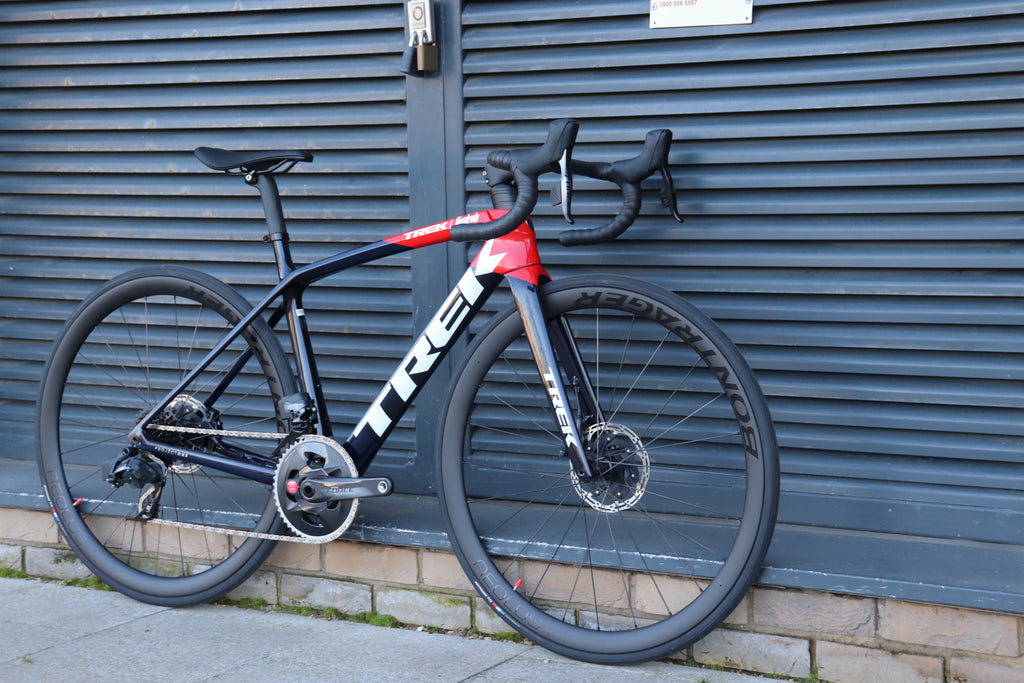
The Emonda's USP has always appealed to a bit of a niche corner of the market; it is incredibly light. So light in fact that it has for years been known as one of if not the lightest mass-produced bike frame available. But the little known secret of these super lightweight climbing bikes is that position and geometry wise, they actually represent a highly lucrative and profitable place for the cyclist.
Somewhere between the super-aggression of the Madone and the super-comfort of the Domane, the Emonda's geometry offers a snappy and responsive ride that won't break your back.
They're also incredibly light - scary light. We have had one in store that weighed just 4.8kg! Sure, this might not be in the reach of most people or even to their liking but their is a very simple fact to the Emonda that the others can't come close to. By being a super lightweight starting point, no matter what build you buy or do, it is going to be considerably lighter than the competition. This means that on those horrible climbs there's going to be even less weight being lugged up and thus getting the pain over with sooner.
Like most current generation aero bikes, the Emonda SLR has seen a push to slightly more aerodynamic design features. So gone have the round tubes of days gone by and in come slightly more tear dropped and aerodynamically functional tubing. There is also the addition of more integration, with internal cable routing and the ability to run a fully integrated bar and stem. But all these mod cons don't add needless weight. They help to improve an already world-class bike, which still somehow keeps that overall weight down without needing to be a bare bones frameset.
Buy The Emonda If:
- You're a weight weenie and love seeing how light a bike you can make.
- Neither an all-out aero or all-out endurance geometry is for you.
Shop Trek Emonda
More articles
Help & information, cycle exchange.
Cycle Exchange Store 27 Sury Basin Kingston Upon Thames KT2 5NZ
Call +44 20 8546 8289
Email [email protected]
Opening Times
Monday: 09:00 – 17:00 Tuesday: 09:00 – 17:00 Wednesday: 09:00 – 17:00 Thursday: 09:00 – 17:00 Friday: 09:00 – 17:00 Saturday: 09:00 – 17:00 Sunday: 11:00 - 15:00
Cafe Mon–Sat: 08:30 – 16:00 Sun: 08:30 – 15:00
Trek bikes range: which model is right for you?
- Sign up to our newsletter Newsletter
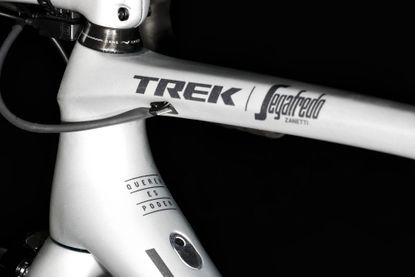
The humble beginning of Trek bicycles took place in the "red barn" - once a carpet warehouse - in Waterloo, USA. The first bikes were steel touring frames , but within three years the brand had expanded substantially.
Eventually outgrowing the barn, Trek moved into a much larger headquarters - still in Waterloo - in the year 1980. From there it began to manufacture road racing bikes, then in 1983 created its first mountain bike before moving into accessories come 1984.
Having started out in steel, Trek moved into developing aluminium bikes in 1985. The first Trek branded full carbon frame came in 1989 - the Trek 5000 had a frame weight of 1.5kg. It was built by an outside manufacturer and discontinued after a year. Trek made its own efforts at carbon, with an in-house production, in 1992 to much greater success.
>>> Trek mountain bikes: which model is right for you?
Now, Trek offers the Madone (aero bike), Domane (endurance bike), Emonda (lightweight race bike) and Checkpoint (gravel bike) as well as the Boone cyclocross and Speed Concept time trial machine.
Trek's OCLV Carbon
You can trust Cycling Weekly. Our team of experts put in hard miles testing cycling tech and will always share honest, unbiased advice to help you choose. Find out more about how we test.
Trek's carbon bikes have always used their own patented 'OCLV carbon' - this stands for Optimum Compaction Low Void. It believes this carbon creates the best compromise between low weight and high strength and stiffness.
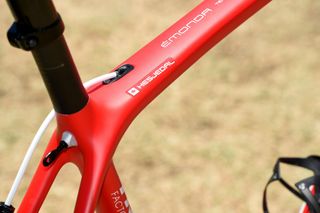
Optimum Compaction refers to the way sheets of carbon are layered into the mould, and optimised via heat and pressure - in Trek's opinion the two treatments are administered to the perfect ratio. Low Void refers to the minimisation of space between the layers of carbon, which might otherwise reduce strength and durability.
In 1995, Trek opened an independent facility inWhitewater, Wisconsin. The idea being that the Waterloo factory would work in frame development only. For those who want to customise their ride, the'Project One' custom paint programme arrived in 2001.
Trek's pro cycling support
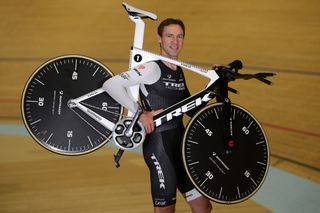
Trek supported now disgraced American cyclist, Lance Armstrong, through his peak years. In 1997, it helped him sign with their sponsored team, US Postal Service Pro Cycling. He won his seven editions of the Tour de Frances on bikes bearing the brand name, but all of said wins were later taken from him following doping violations.
In 2014, the brand sponsored the Trek Factory Racing Team, now calledTrek–Segafredo. In that role, it provided bikes for high profile winners such as Fabian Cancellara and Alberto Contador,as well as Jens Voigt, and notably his Hour Record in September 2014.
In 2020, Trek continued to support the Trek-Segafredo men's and women's race outfits, two highly successful teams.
Trek's acquisitions
Over the years, Trek has made a number of high profile acquisitions. The most famous, perhaps, Gary Fisher bicycles - the mountain bike brand which it took over in 1993.
Later came Bontrager Cycles in 1995 and Electra Bicycle Company in 2014. Bontrager, now Trek's component and apparel brand, maintains the same name as does Electra, the creator of leisure bikes and accessories.
Useful links for road bike shoppers…
Trek's road bike models
Trek is able to offer a wide range of different bikes, each tuned to a slightly different purpose. Some model families are available in a selection of standards (SLR premium carbon, SL carbon, ALR premium aluminium and AL aluminium), and then these come with assorted levels of componentry to suit your price bracket.
To add even more depth to the range, Trek offers many models in two different 'fits'. The Madone and Émonda come as standard in an H2 (traditional) fit, but there are versions in what it calls 'H1' fit. This is more aggressive, shaving off about 30mm on the head tube to create a longer, lower ride. The Domane comes in an H2 'Endurance' fit, with a few models in 'Pro Endurance', again with a longer and lower stance on offer.
Here's a look at the key model families...
With each product is a ‘Buy Now’ or ‘Best Deal’ link. If you click on this then we may receive a small amount of money from the retailer when you purchase the item. This doesn’t affect the amount you pay.

Trek Domane
Our expert review:
Reasons to buy
Reasons to avoid.
The Trek Domane was introduced in 2012. It was created to offer a comfortable ride, the key feature being an IsoSpeed decoupler which separated the seat tube from the top tube, thus reducing vibrations and fatigue.
In 2016 it gained theFront IsoSpeed, which helps to reduce vibrations at the front end without impacting handling. This came alongside a new slider, which alters the level of dampening offered by the rear.
In its most recent update , the Domane took notes from the Madone with an aero fork profile, whilst becoming more versatile thanks to clearance for 38mm tyres (without mudguards, 35mm with). It also gained a downtube compartment for stashing tools (or snacks!).
Though comfort is important to the Trek Domane, it's still a racing frame, and its prowess has been demonstrated by UCI WorldTour riders at major one-day Classics, such as Strade Bianche and the Tour of Flanders. The top Domane bikes come with an H1.5 fit, which was developed with the Trek-Segafredo teams to offer the optimal balance between aerodynamics and endurance.
The Trek Domane - available as a men's build or with women's specific componentry - is a fast selling model, which comes in a range of frame materials.
The Domane SLR uses the lightest carbon Trek offers, the SL is one step down, whilst the AL uses aluminium and is the cheapest of the range.
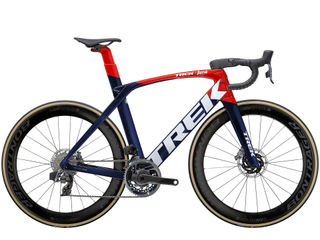
Trek Madone
The Trek Madone is quite another beast, and the bikes come built for men and women; the latter's models with women's saddles and narrower handlebars . With an aggressive geometry and stiffness to boot, it's a road race hero, and aerodynamics have become part of its lifeblood. When we tested five aero bikes , head to head, the Trek Madone came out fastest.
Modern Trek Madone's feature a high level of integration, with the cables tucked away yet reachable via an access point at the top of the down tube.Wind tunnel testing has helped Trek to create theirKVF (Kammtail Virtual Foil) tube shapes, used on the frame and fork. These unconventional tube shapes are designed to further reduce drag, helping the rider/bike unit to slice through the air efficiently.
Because being bumped around doesn't make you faster, the Madone also features an IsoSpeed decoupler at the seat tube and more recently an adjustable one at the head tube, which offers greater compliance whilst still being integrated to prevent adding drag.
The newest model, according to Trek, can offer 17 per cent more compliance through to 21 per cent more stiffness, depending upon your chosen setting. A damper at the seatpost is also said to cut rebound by 13 per cent. All of these stats add up to a bike that can be comfortable and stiff at the same time - and one that earned a place in our 2018 Editor's Choice awards.
The majority of the bikes come in a more relaxed 'H2' geometry, save for the Madone SLR, which is in an 'H1.5' fit - this is designed to allow riders to achieve an H1 fit or an H2, depending upon their set up.

Trek Émonda
Adding more depth to the Trek family is the Trek Émonda, launched in 2014. Designed to be a climbing bike, newer adaptations are capable of negotiating mixed terrains - with disc brakes available and tyre clearance to 28mm.
>>> Trek Émonda range explained
Trek continues to work on developing the Émonda, dropping the weight of the top end Trek Émonda SLR to 640g in a size 56cm (665g with discs) and 1091g for the Trek Émonda SL (1149g with discs). The weight difference is largely achieved by the use of700 Series OCLV carbon on the SLR, as opposed to 500 series on the SL.
The aluminium model has seen some major work and the result earned it a place in the Editor's Choice 2019 awards. The key characteristic we loved was the way it simply didn't look, or ride, like aluminium. A lot of this is down to Trek's 'Invisible Weld Technology' which increases the surface area of the frame, adding to strength and reducing weight. The ALR model's frame weight comes in at a competitive 1112g, or 1131g with discs, and it uses the brand's 300 Series Alpha Aluminium.
The carbon models are available in 'SLR' build or 'SL', the former being the lightest and the latter more affordable. The majority of Trek Émonda bikes cone in an 'H2' fit, but they can be purchased in an 'H1' geometry, if you choose the top end 'Race Shop' version.
There are a few nods to neatness and integration around, such as the use of 'Blendr Integration' which seamlessly mounts Bontrager’s cycling computer, Ionbike lights or even Garmin computers directly to the handlebars. On SLR versions there's ‘Control Freak Cable Management’ which allows for shifter and brake cables to be housed through the frame.
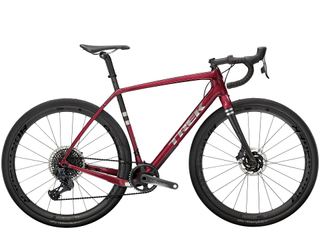
Trek Checkpoint
With gravel and adventure bikes a fast growing category, the Checkpoint is Trek's offering to fill that sector. The crucial element here is that both the SL and ALR frame options come fitted out with 35c gravel tyres, and can accommodate rubber up to 45c. They've all got internal cable routing, to ensure much stays out, whilst the higher end models use 'Control Freak' routing which is neater.
>>> Best gravel bikes: the top models reviewed
If you opt for the carbon SL model, you get vibration dampening from an IsoSpeed decoupler at the rear, too. To provide stability and confidence on light trails as well as comfort on all-day adventures, the geometry is not as aggressive as the road bikes elsewhere in the range. Such all-day rides warrant plenty of kit, so there's mounts for racks and mounts. Similar to elsewhere in the range, there's AL, ALR and SL models.
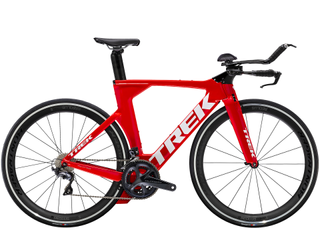
Trek Speed Concept
Trek's Speed Concept time trial bike has been raced by the pros yet is still seen on the amateur race scene as a popular option.
>>> Check out Fabian Cancellara's 2016 Speed Concept
The frames use 500 Series OCLV Carbon, boasting the KVF (Kammtail Virtual Foil) tube shapes described in the Madone, plus a carbon fork with integrated brake and stem - the key goal being cutting through the air quickly.There's space to fit Trek's SC Draft Box and SC Sped Box, largely used by triathletes carrying snacks.
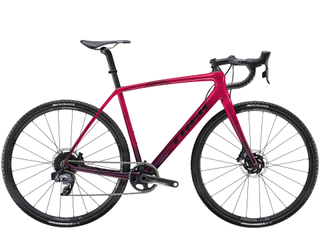
Trek Boone 5
Trek's got plenty of experience in the muddy realm of off-road cycling - and they've got a selection of cyclocross bikes. The Trek Boone 7 model comes with hydraulic disc brakes, a one-by crank and 12-speed cassette and they've all got Bontrager's own 33c cyclocross tyres.
The frame material is Trek's 600 series OCLV carbon, and there's front and rear IsoSpeed decouplers to help riders negotiate the mud without excess transfer of vibration. Combining the mud ready tyres, disc brakes, 'cross focused cable routing and geo into an aluminium package is the Trek Crockett family.
They key differentiation is the frame material, which is300 Series Alpha Aluminium, and there's no decoupler. However, it's still a performance bike that's ready to race.
Thank you for reading 20 articles this month* Join now for unlimited access
Enjoy your first month for just £1 / $1 / €1
*Read 5 free articles per month without a subscription
Join now for unlimited access
Try first month for just £1 / $1 / €1
Get The Leadout Newsletter
The latest race content, interviews, features, reviews and expert buying guides, direct to your inbox!
Michelle Arthurs-Brennan the Editor of Cycling Weekly website. An NCTJ qualified traditional journalist by trade, Michelle began her career working for local newspapers. She's worked within the cycling industry since 2012, and joined the Cycling Weekly team in 2017, having previously been Editor at Total Women's Cycling. Prior to welcoming her daughter in 2022, Michelle raced on the road, track, and in time trials, and still rides as much as she can - albeit a fair proportion indoors, for now.

British rider remembers his victory at Paris-Roubaix juniors
By Tom Thewlis Published 4 May 24

Alfonsina Strada made headlines when she entered the 1924 edition of the Giro d’Italia, under the name 'Alfonsin', and the story of her grit and determination to finish against all odds lives on today
By Giles Belbin Published 4 May 24
Useful links
- Tour de France
- Giro d'Italia
- Vuelta a España
Buyer's Guides
- Best road bikes
- Best gravel bikes
- Best smart turbo trainers
- Best cycling computers
- Editor's Choice
- Bike Reviews
- Component Reviews
- Clothing Reviews
- Contact Future's experts
- Terms and conditions
- Privacy policy
- Cookies policy
- Advertise with us
Cycling Weekly is part of Future plc, an international media group and leading digital publisher. Visit our corporate site . © Future Publishing Limited Quay House, The Ambury, Bath BA1 1UA. All rights reserved. England and Wales company registration number 2008885.

Trek Domane Vs. Emonda: Key Differences Explained

Trek is one of the top bike manufacturers in the world, and the brand is responsible for designing a few high-end bikes that often compete at the world tour level.
Trek specializes in designing road bikes for the most part, and they are known for their UCI team that competes in world tours. Trek Segafredo has an impressive history of performance in these tours.
The main difference between the Domane and Emonda is the design and purpose of these bikes. The Domane is mostly made for endurance road races. Additionally, the Emonda is more of a traditional road bike, which focuses more on performance and speed. However, both these bikes are dominant in their disciplines .
Since cyclists will often need to decide between these two behemoths, we must break them down to find out which one would suit you best.
This article aims to have a closer look at which of these bikes offers the best overall performance. Now, you can decide which one is best for you.
Trek Domane Vs Trek Emonda Overview
To get the best understanding of each bike, we should look at why they are made and which disciplines they would excel at.
To do this, we studied some of the features and spoke to professional riders, and it became clear which bike serves the purpose.
Here is the idea and concept behind the Trek Domane and Emonda bikes:
1- Trek Domane
The Trek Domane features a more upright design when looking at geometry and offers the rider more comfort when pedaling .
The frame construction will give you outright stability, which gives a few hints of gravel bikes. The bike is perfect for cobblestone and gravel sections due to its additional clearance.
Unfortunately, it is not ideal for road racing, and you won’t have the same agility that many top road bikes boast . It can endure more terrains, and due to the upright geometry, riders suffering from back pain would also find it to be one of the most useful options currently available.
The video below shows Trek Domane’s characteristics.
2- Trek Emonda
On the other end of the spectrum, we have the Trek Emonda. When you put these bikes side by side, the differences are hardly noticeable to the untrained eye . It is the lightest bike in the Trek range available to the public.
However, plenty of focus has gone into making it as aerodynamically resistant as possible .
While it might be an expensive bike, the lighter weight and agility will make it ideal for beginners looking to become better road cyclists.
The bike can comb through a series of corners, and when you tuck in, you can resist plenty of the wind. Overall, the Trek Emonda bikes would do better for road bike races due to the lighter weight and performance-driven design .
The video below shows Trek Émonda characteristics.
5 Key Differences Between The Trek Domane And Trek Emonda
You might have noticed some of the key differences between these bikes from the overview. However, looking at the critical bike and road cycling features is best to see where they differ.
This section has identified a handful of crucial elements that make a road bike great. Now we can look at a few differences:
1- Geometry
The first thing to look at is the geometry of the bike. The Trek Domane is more upright, which means the rider does not have to bend over as much when it comes to riding .
Your seat is slightly pulled back, preventing your back’s overuse in strenuous positions. The overall design would lead to more stability on various terrains.
For the Emonda, Trek focuses on making the bike aerodynamically efficient. This means that you would find a higher bottom bracket with less clearance.
The seat is slightly angled, and the bike forces the rider to bend over slightly when it comes to performance . You will generate more speed, but the ride could be uncomfortable.
Winner : Trek Domane
As previously stipulated, the Emonda is the lightest bike in the Trek range, which is in line with most road racing bikes made for performance.
The Emonda SLR9 comes in at just under 15-pounds, keeping it in line with the UCI regulations for bikes. It can easily be used for maneuvering the bike.
On the other end of the spectrum, the Domane SLR9 is slightly heavier. It weighs 17.2-pounds. This might not seem like much to a beginner, but it can make a big difference to speed and agility.
If weight is the main issue, you would want to consider the Emonda to keep the weight down.
Winner : Trek Emonda
3- terrain performance.
You often need to look at the terrain you will be riding on when choosing the ideal road bike. While road bikes are made from the road, you could come across gravel sections and cobblestones. Cyclocross bikes would be used for a combination of road and off-road surfaces.
The Trek Domane features a more rigid design, and the clearance is slightly higher. Due to the better clearance, the Trek Domane bike is suited for just about any terrain you might encounter . If you want to jump the pavement or sidewalk or if you have a few large cobbles to overcome, this is the bike to choose.
For the Emonda, we have a lower bottom bracket, which reduces the clearance slightly and could make it harder to overcome some of these obstacles. The Emonda is not as rigid, and it would be much harder to endure some of these excessive obstacles when you are driving on variable terrains.
4- Speed Performance
When performance is at stake, you want the fastest bike you can find. However, the speed is not always concrete, and while one bike might be fast on one terrain, the opposite might be true for different terrain. For a flat surface, the Emonda would offer you better speed performance.
If you are riding cobbled sectors or have to endure a wee bit of gravel, the Domane might be the better option . It might not have the outright speed that the Emonda has, but it would make it possible to ride faster over these surfaces.
In terms of outright speed, the aerodynamic nature of the Emonda makes it the best option.
Another important aspect of your bike you need to look at is the pricing of the bike. You should consider which of them fits your budget. The Trek Emonda and Trek Domane have various editions, which range in features and performance. Both of these bikes have an SLR6 to SLR9 version, with the latter being the most expensive.
By comparing the prices, we see that the retail price for the Trek Emonda SLR6 is about $6,699.99. The retail price for the SLR6 Domane is $6,799.99. For the SLR9, the Emonda is $12,249.99, and the Domane is $12,549.99 . As you can see, the prices of both these bikes are very similar, with the Emonda being slightly more expensive.
There are also additional versions of this bike in between. However, the pricing trend takes a similar pattern.
Overall, the Emonda is slightly more expensive when you move higher up on the train of features . This might also be because road racing is slightly more popular than endurance racing, which could boost the price.
Table below compares Trek Domane And Trek Emonda Pricing
Winner : Trek Domane (Cheapest)
Which one is the best: trek domane vs. trek emonda.
Emonda and Domane are from the same brand, so they have more leeway to play around with the tech features. While both bikes look and feel similar, they have different purposes. The Emonda is mostly for road races, whereas the Domane is more for endurance racing. As an example, the Emonda would work best at the Tour de France. The Domane is the better bike for the World Road Racing Championships.
With such similar features, it is hard to determine which of them are the best, and it would come down to personal preference. If we look at tour bikes like Calnaco and even Cannondale, we will find that the features are very similar to the others. The main idea is that manufacturers compete to build the best bikes but often use the same technology.
Unfortunately, we cannot declare one a winner over the other as the circumstances for comparison need to be measured.
One thing we can say is that neither of these bikes would serve as mountain bikes and, they are best avoided when it comes to professional cyclocross racing.
The table below summarizes the differences between Trek Emonda And Trek Domane bike
Is Emonda Good For Long Rides?
Generally, Emonda bikes are suitable for long rides. In addition, they are comfortable bikes and can handle rough terrains, including gravel roads and even trails.
Trek Emonda is Trek company’s most lightweight road bike, best for road racing. Its lighter weight makes it more suitable for racers and climbers because it is easy to ride uphill with a more lightweight bike than a heavier one.
Wrapping Up
It is hard to find the best bike on the market, and if you have the budget, you could consider both the Trek Emonda and Trek Domane.
These are some of the most expensive bikes on the market today, but they offer exceptional value for the money. Let us know in the comment section if you have ever ridden on one.
Hello fellow bikers, I am Altiné. I am SO excited you are here! I am the guy behind bikerify.com. I am a biker and very passionate about reading, sports, and all things outdoors. I hope you find what you are looking for while visiting bikerify.com.
Recent Posts
9 Reasons Why Every Cyclist Needs a Bike Repair Stand
This post contains affiliate links. A biker using a bike repair stand Biking is not only a great form of exercise, but it is also an environment-friendly mode of transportation. However, like...
Are Electric Bikes Good For Exercise? (With pros of using E-bikes!)
Electric Bike Rider Cycling is a great way to get fit, but not everyone enjoys the intensity of traditional biking. That’s where electric bikes come in. Electric bikes use an electric motor to...

Trek Emonda Vs Domane [Which Bike Is Better]
Are you in the market for a new road bike and can’t decide between the Trek Emonda and Trek Domane?
This comparison will help you make the best choice for your cycling goals. The Trek Emonda is a lightweight, race-ready bike with responsive handling and efficient pedaling. The Trek Domane is a comfortable, all-around bike with a stable ride and added compliance.
Both bikes offer excellent performance and are well suited for endurance riding, but each has its own unique advantages. Let’s find out which bike is the better option for you!
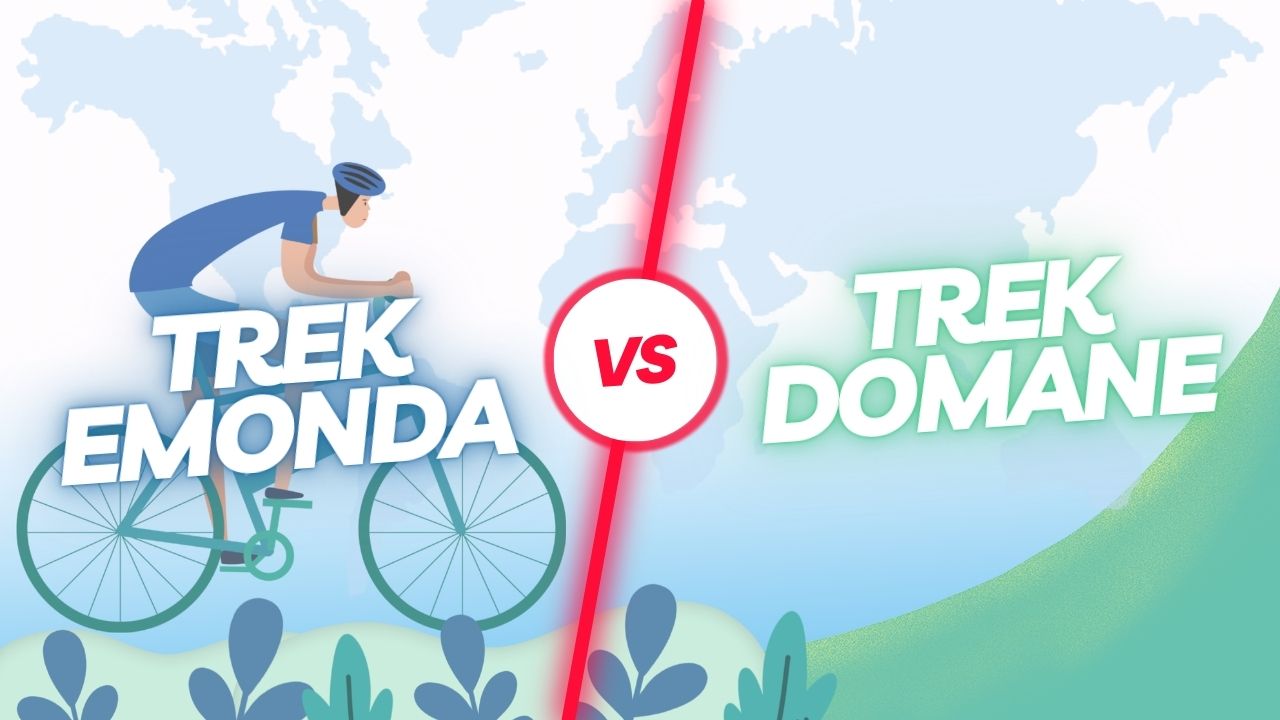
Things That Make The Trek Emonda Good!
Developed with the help of Trek’s pro riders, the Emonda range offers a wide variety of options, from lightweight aluminum to the lightest production carbon fiber bike ever made.
Whether you’re a casual rider or a serious cyclist, the Emonda has something for everyone. The Emonda is designed to be fast and responsive, with a stiff frame and a low center of gravity.
The frame is made from Trek’s OCLV carbon, which is light and stiff yet still absorbs vibration for a comfortable ride. The frame also features Trek’s IsoSpeed decoupler, which allows the seat tube to flex for a smoother ride. The Emonda is equipped with Shimano components, including the latest Ultegra Di2 electronic shifting system.
It also comes with powerful hydraulic disc brakes for confident stopping power in all conditions. The bike is available in a variety of sizes and can be customized with a range of components to suit your individual needs. If you’re looking for a lightweight and responsive road bike , the Trek Emonda is a great choice.
What Is Trek Domane Bike
This all-road bike is designed to provide a smooth and efficient ride on any terrain, from the pavement to the dirt. The Domane features an IsoSpeed decoupler that isolates the seat tube from the top tube and seat stays, providing a smooth ride even on rough roads.
The frame is also designed to absorb road vibrations, making for a more comfortable ride.
The Domane also features a lightweight frame and components, making it easy to maneuver and accelerate quickly. The Domane also has a wide range of components that make it suitable for a variety of riding styles.
It comes with Shimano Ultegra components, which are designed to provide reliable and precise shifting. The Domane also comes with a carbon fork.
With its wide range of components, the Domane is a great choice for any rider looking for a reliable and comfortable all-road bike. Trek Emonda VsTrek Domane Bike!
Weighing in at just over 12 pounds. It features a stiff, responsive frame and a full carbon construction. The Trek Emonda is designed for comfort and stability and features a more relaxed frame geometry.
The Domane on the other hand, also features a full carbon construction, but it is slightly heavier than the Emonda at around 15 pounds. Both bikes are well-suited for long rides, but the Emonda is better for racing and fast rides, while the Domane is better for endurance and comfort.
The Trek Emonda has a pair of lightweight carbon wheels that provide superior stiffness and strength. The wheels feature a 50mm depth and a 24mm internal width, providing riders with a fast and responsive ride.
The wheels are compatible with tubeless tires . The rims are also designed to be aerodynamic, reducing drag and improving overall speed.
The Trek Domane has aluminum alloy wheels that provide a lightweight and durable ride. The wheels feature a 30mm depth and a 19mm internal width, providing riders with a fast and responsive ride.
The wheels are compatible with both tube and tubeless tires . The rims are also designed to be aerodynamic, reducing drag and improving overall speed.
The Trek Emonda and Domane both are equipped with a Shimano Ultegra 11-speed drivetrain. This drivetrain consists of Shimano’s Ultegra 6800 shifters, derailleurs, and cranksets.
The crankset is a 50/34t compact setup and the cassette is an 11-32t. This drivetrain provides a wide range of gears for climbing and descending.
Additionally, the Domane bike is equipped with a Bontrager Pro Rear Derailleur Cage for improved shifting performance.
The Trek Emonda is equipped with a Shimano Ultegra hydraulic disc brake system. This system provides excellent braking power and modulation, allowing you to confidently control your speed in any condition.
The Shimano Ultegra system also offers excellent durability, so you can count on your brakes to perform for many miles.
The Trek Domane is equipped with Shimano Ultegra brakes as well. But this time, it’s the mechanical disc brake system. The mechanical system provides reliable and powerful braking, so you can confidently control your speed in any condition.
Sure, it’s not as fancy as hydraulic, but it gets the job done, and paired with the right sets of tires, you can have a great braking performance on regular terrain.
It’s one of the few instances where both bikes share the same thing. The Domane and Emonda both are equipped with IsoSpeed, an in-house suspension designed by Trek to improve the seat cushioning and make it more comfortable for longer rides. If you are planning to cycle a marathon, you could do with this bike really well.
The cockpit of the Trek Emonda is designed for a more aggressive riding position and features a short stem, shallow drop handlebars, and a wide range of adjustments.
The Trek Domane cockpit is designed for a more upright riding position and features a longer stem, shallow drop handlebars, and a wide range of adjustments.
Accessories
Out of the box, neither of the bikes has any accessories. Like always, Trek expects you to pay some extra for the much needed accessories. Here is a list of accessories that are supported by both of the bikes and are worth looking into if you are considering long rides.
Trek Bike Accessories
Water Bottle Cage: A water bottle cage is essential for any bike ride, and the Trek Emonda has a lightweight aluminum cage that is designed to fit any standard water bottle.
Saddle Bag: A saddle bag is a great way to store small items such as keys, wallet, and cell phone. The Trek Emonda saddle bag is made from durable nylon and has a waterproof zipper to keep your items safe.
Lights: Lights are a must for any bike ride, and the Trek Emonda has a set of lights that are designed to be seen from a distance. The lights are powered by a rechargeable battery, so you won’t have to worry about replacing them.
Mudguards: Mudguards are essential for keeping your bike clean and free of dirt and debris. The Trek Emonda has a set of mudguards that are designed to fit the bike perfectly and keep you dry in wet conditions.
Rear Rack: A rear rack is a great way to carry items such as a backpack or groceries . The Trek Domane has a rear rack that is designed to fit the bike perfectly and is made from durable aluminum.
Trek Emonda Vs Trek Domane – Similarities
The Trek Emonda and Trek Domane bikes are both made by the same company and feature many similar components.
Both bikes have a lightweight frame, adjustable handlebar and stem, and a Shimano drivetrain. However, the Emonda is designed for road racing, while the Domane is designed for endurance riding. The Emonda has a more aggressive geometry, a stiffer frame, and larger wheels than the Domane.
The Domane has a more relaxed geometry, a more compliant frame, and smaller wheels than the Emonda. Both bikes also feature a wide range of components, with the Domane offering a more customizable setup.
Frequently Asked Questions
What is the main difference between a trek emonda and a domane.
The main difference between a Trek Emonda bike and a Trek Domane bike is the frame.
The Trek Emonda is designed for racing and is more aerodynamic than the Trek Domane, which is designed for comfort and stability. The Trek Emonda also has a higher gear range than the Trek Domane, making it better suited for climbing hills.
What Type Of Terrain Is Best Suited For A Trek Emonda?
Trek Emonda bikes are best suited for riding on flat terrain, such as roads, paths, and trails.
They are lightweight and designed for speed, so they are not ideal for riding on rough terrain or off-road.
Trek Domane bikes, on the other hand, are designed for more rugged terrain and are better suited for off-road riding.
What Type Of Components Are Included On A Trek Domane Bike?
Trek Domane bikes include the following components:
Frame: Trek’s IsoSpeed decoupler technology provides a smooth ride and improved comfort.
Wheels: Bontrager Aeolus Pro 3V wheels are lightweight and aerodynamic.3. Drivetrain: Shimano Ultegra Di2 electronic shifting provides precise and reliable shifting.
Brakes: Shimano Ultegra hydraulic disc brakes offer powerful and consistent braking performance.
Cockpit: Bontrager Pro IsoCore handlebar and stem provide a comfortable and ergonomic riding position.
Saddle: Bontrager Montrose Elite saddle is designed for long-distance comfort.
Final Words
Both bikes offer excellent performance and quality, making them ideal for a wide range of riders. The Trek Emonda is a lightweight and responsive race bike that is perfect for competitive cyclists and those who want to go fast. The Trek Domane is a more comfortable and stable ride that is great for long rides and touring.
Both bikes are great choices for everyday cruising on your local roads or a little bit of hill climbing. But if your cruise is climbing only, then the Domane has an edge there. Ultimately, it will depend on what you want from the bike. A comfortable daily ride?
Both of them go. Specifically for flat terrain races? Then Emonda. You can’t go wrong with either choice. Make sure to go through the customization section to modify the bike to suit your needs more.
Laura Anderson
Hi, I am Laura Anderson. I am a renowned Lady biker in my neighborhood. So, Mike introduced me to his beloved friend Mehedi. So that I can talk with you about my experience and renovation of cycles, especially those that are used by females. But having knowledge about the bikes, I have written and will be written.
Sram SX Vs NX [Which Groupset Is Better?]
Shimano claris vs sora [which groupset is better], leave a reply cancel reply.
Save my name, email, and website in this browser for the next time I comment.


- X (Twitter)
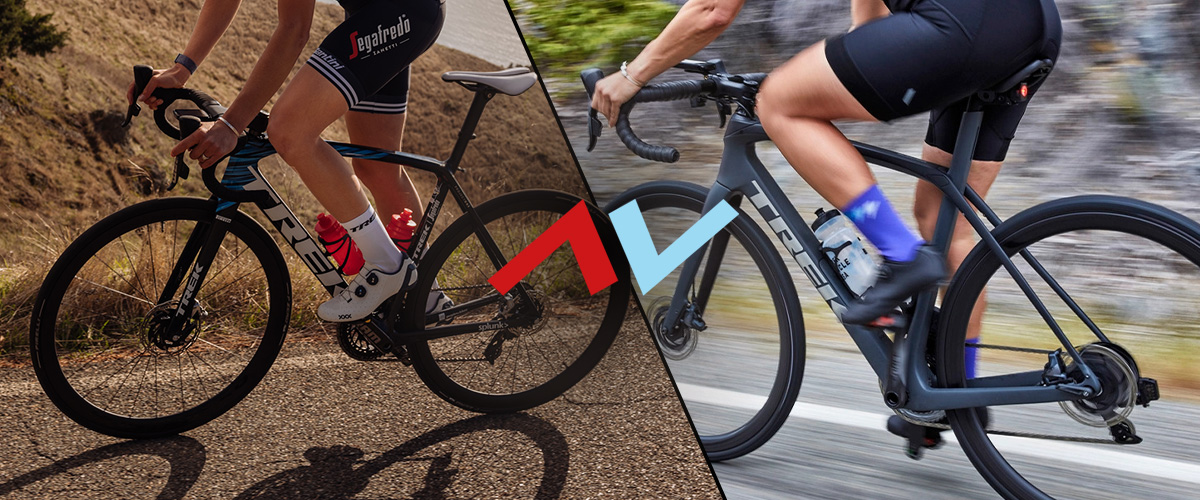
Road Bike Guide: Trek Domane vs Trek Emonda 2023
Battle of the bikes: domane vs emonda.
Trek’s range of road bikes has a well-earned reputation for being some of the best in the business, with each of their respective roadies earning extensive palmares ranging from the cobblestones of Roubaix to the high mountains of Le Tour de France. While most of us might not be World Tour pros, the benefits of each bike still apply to the average Joe – so whether you’re a Strava KOM hunter or a casual club rider, Trek has got you covered.
Let’s take a closer look at the bikes in question.
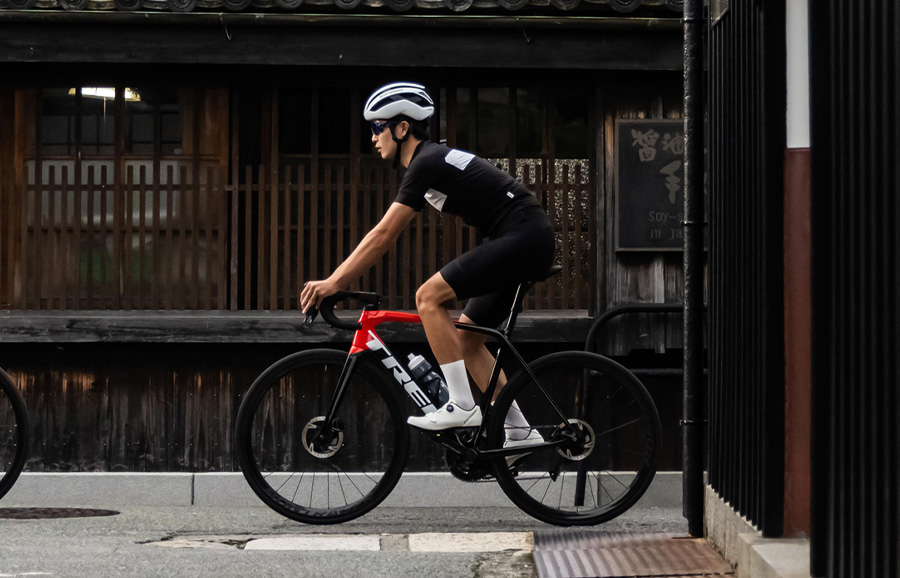
Trek Emonda
This bike fits firmly into the lightweight race bike category, and since its initial launch, it has been at the cutting edge of what’s possible with lightweight bicycle technology. This latest iteration of the Emonda is no different, and it’s faster than ever. Having already been ridden into pink in the 2022 edition of the Giro d’Italia courtesy of Juan Pedro López, it’s evident that this bike is no slouch!
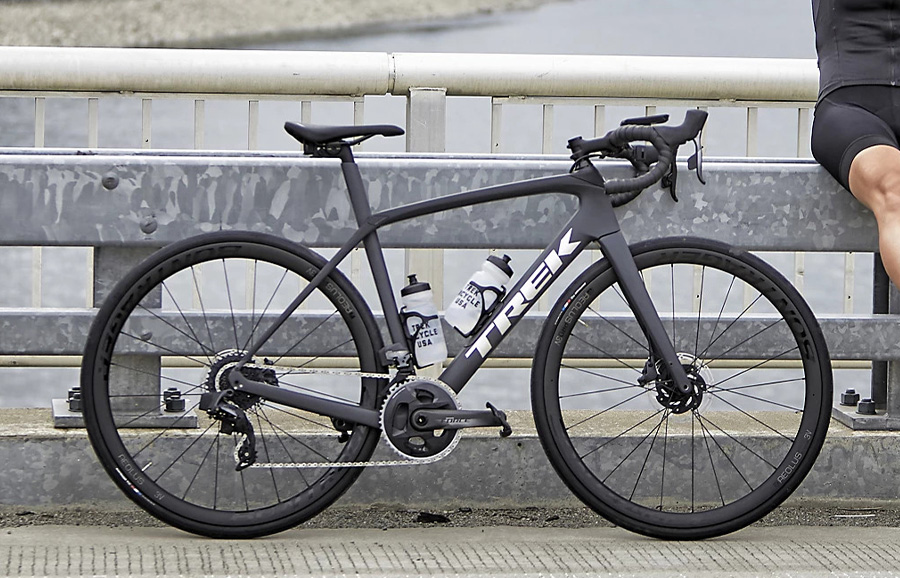
Trek Domane
To simply call the Domane an endurance bike doesn’t do it justice. Developed in conjunction with none other than Fabian Cancellara, the Domane was purpose-built to dominate the cobbles and still does so to this day. With a no-compromise approach, the Domane ensures that comfort doesn’t come at the expense of speed, making this bike one of the most versatile road bike options out there.
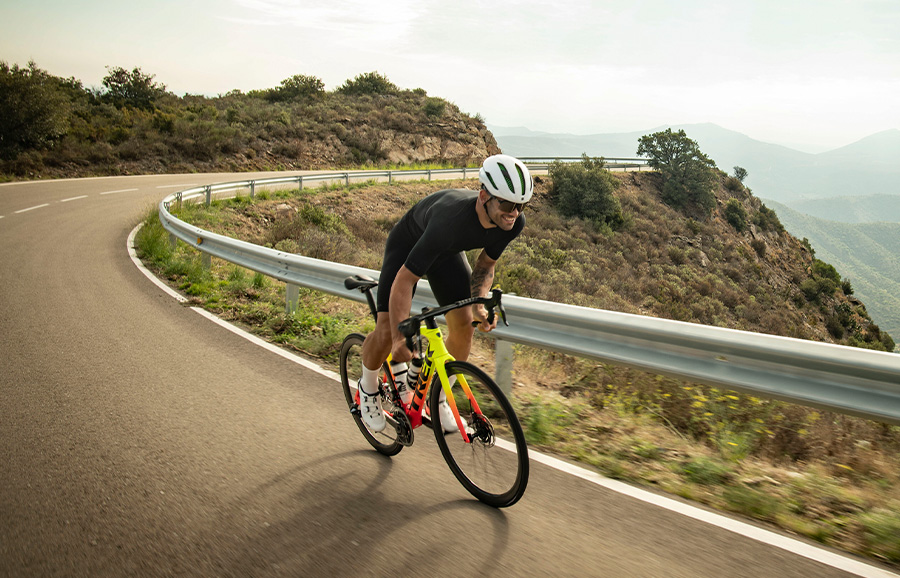
Trek Emonda 5/5
With the Emonda being Trek’s dedicated all-round race bike, speed may as well be its middle name. Since its release, the Emonda has been up there with the lightest production road bikes on the market, and this is still very much the case, but this time it has a trick up its sleeve! This latest iteration is the product of countless hours of testing both on the road and through computer modelling – the lightweight climbing bike has had an aero makeover. Whether it’s stomping up the climbs, descending like a demon or flying along on the flat, the Emonda will do it well and do it fast!
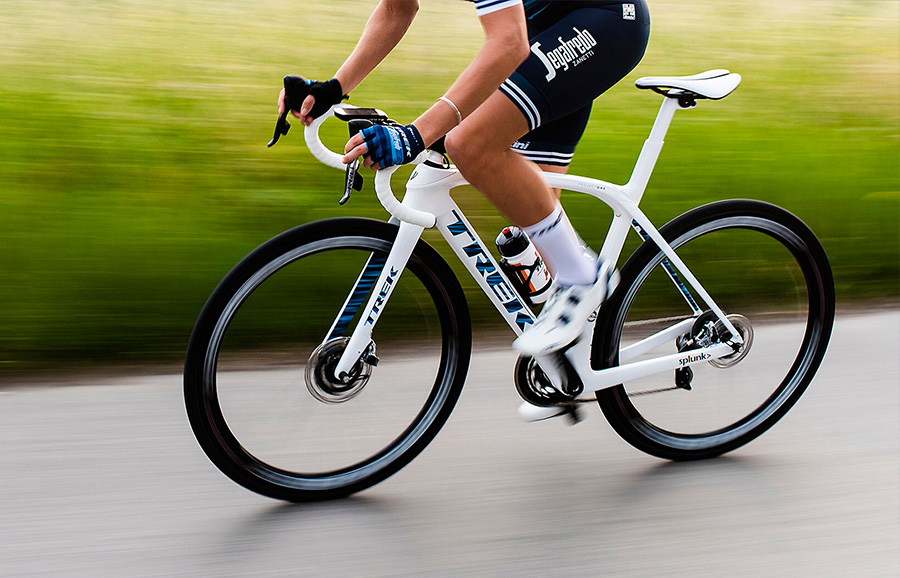
Trek Domane 4/5
The Domane may be an endurance bike, but that certainly doesn’t mean it has to be slow. While it was no slouch to begin with, the latest version of the Domane has also had an aero makeover. Introducing aerofoil tubing and hidden cables while still retaining the same IsoSpeed technology for unrivalled comfort, its race reputation speaks for itself, with this latest edition having been ridden to victory in the inaugural Paris–Roubaix Femmes by Lizzie Deignan in 2021 – if it’s fast enough for her, it’s fast enough for us!
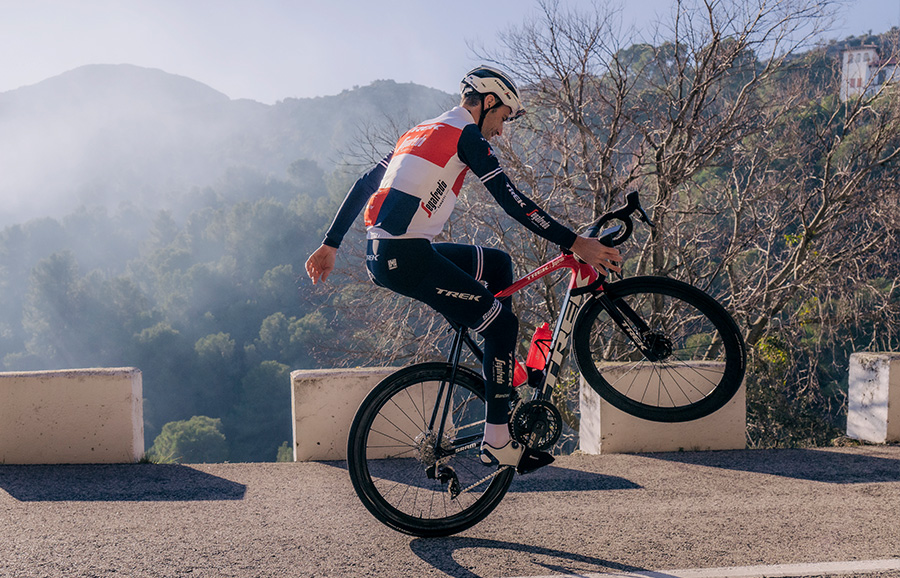
When it comes to the Emonda, low weight goes without saying, and with its new makeover the Emonda bucks the trend that aero has to be heavy. Trek’s latest generation OCLV 800 Series carbon is their lightest yet, meaning that even with deeper section aero tubing, the SLR frame remains below 700g. Pair that with some lightweight wheels and a flash new groupset, and you’ve got yourself a serious featherweight, with the Emonda SLR 7 (equipped with the brand new 12-spd Ultegra Di2 wireless groupset) tipping the scales at just 7.37kg. It’s safe to say that the Emonda comes out on top here!
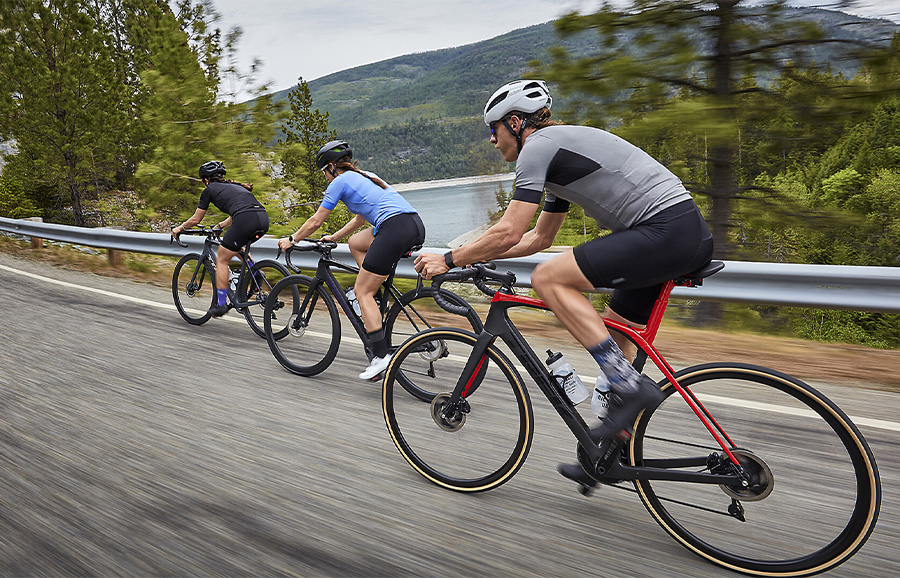
Weight may not be the primary concern with the Domane, and with Trek’s IsoSpeed technology showcased both front and rear, it’s no surprise that it’s carrying a few extra grams compared to the Emonda. With that being said, it’s no lead weight! Utilising Trek’s OCLV 700 Series carbon, the SLR model equipped with 12-spd Ultegra Di2 sits at just shy of 8.40kg – not too shabby considering the armchair-esque ride comfort the Domane provides.
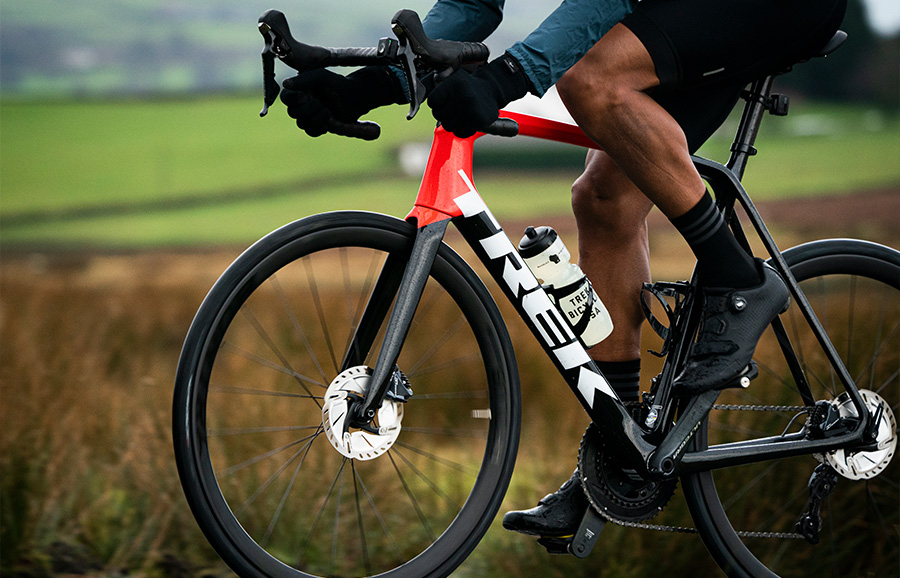
Trek Emonda 4/5
Trek are no strangers to creating cutting-edge carbon, so as well as being their lightest yet, Trek’s OCLV 800 Series carbon has been optimised during the layup process to not only maximise lateral stiffness but also enhance vertical compliance, making for a smooth and responsive ride regardless of the road surface. The days of harsh riding race bikes are over! Of course, geometry also plays an important role in rider comfort, and naturally, the Emonda edges towards the racier end of the scale by putting the rider in an efficient yet sustainable position – comfort hasn’t been compromised, but it’s certainly not a touring bike!
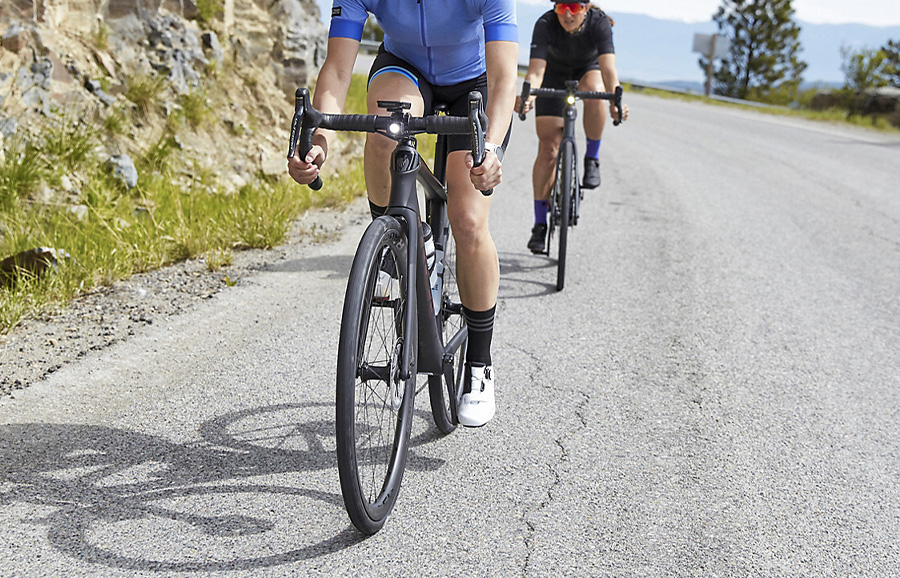
Trek Domane 5/5
Comfort is at the core of the Trek Domane – it’s its speciality! Engineered specifically for racing on the cobbled classics, the ability to soak up road vibrations is critical, which is something that we’re all too familiar with on our home roads. IsoSpeed is what truly sets the Domane apart. Utilised front and rear, the system decouples the tubes at these junctions to allow for increased vertical compliance, almost eliminating the effect of road buzz and bumps without having any effect on the stiffness or handling of the Domane. Coupled with their tried and tested endurance geometry, you’re onto a winner!
Tyre Clearance
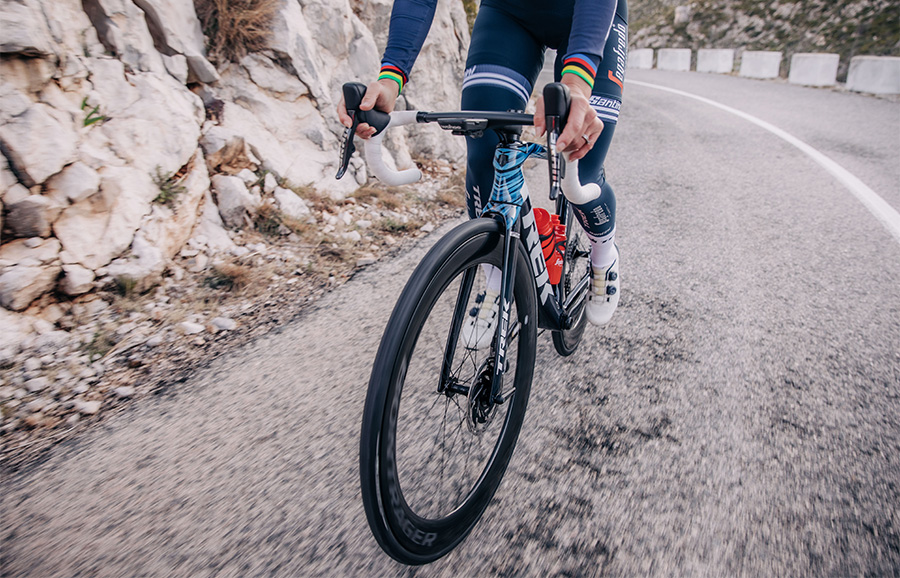
Even the raciest bikes in the world are opting for wider tyres, as not only do they provide significantly improved comfort but they have also been proven to actually offer lower rolling resistance! The Emonda officially accommodates up to 28mm tyres (with room to spare!), and as far as racing is concerned, this is perfect – the ideal blend of comfort and speed. Not only that, but the Emonda’s aero features have been designed around the use of 25-28mm tyres, so there’s no reason to go skinny!
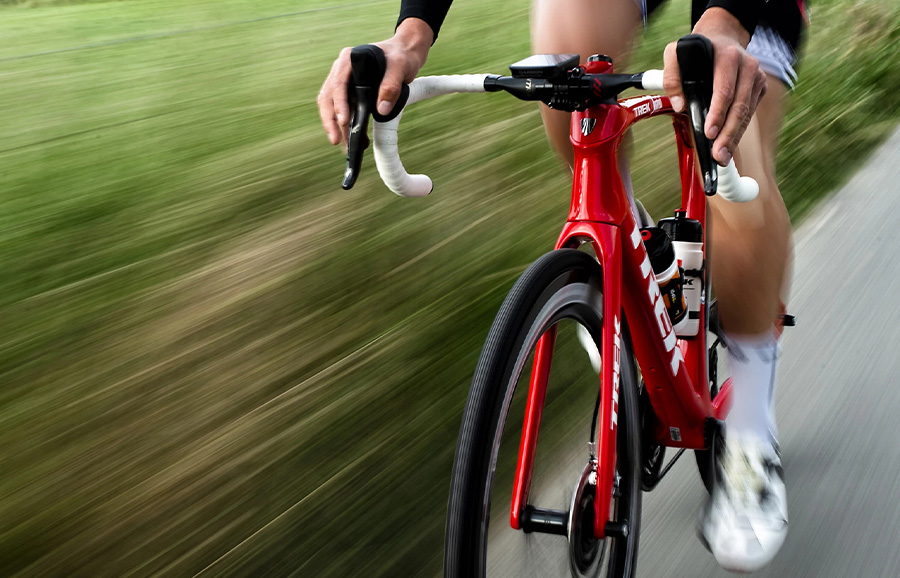
As you might expect, the Domane has no shortage of tyre clearance at its disposal – 38mm to be precise! This dwarfs the clearance that most rost bikes offer, including the Emonda, and while tyres of this width may be marginally slower than something in the range of 23-28mm, here you have the freedom of choice. If you’ve got a race coming up, faster-rolling 28s will fit just fine. If you’re rolling out on a multi-day tour on unfamiliar roads, throw on some chunkier rubber and you’ll be comfy and confident on unruly surfaces – the Domane could even double up as a gravel bike if you’re that way inclined!
The Verdict
Ultimately your choice comes down to what suits your needs. If you’re chasing seconds in a race, trying to claim all of your local segments on Strava, or punishing your friends on the chaingang, the Emonda could be the way to go. For the everyday rider, whether it’s on a club run, sportive or ultra-endurance event, the Domane will serve you well (but will still be handy in the odd town sign sprint!). To discover our range of bikes on offer, visit us in Ashford or Folkestone – we have plenty in stock and ready to go, and we’re always up for bike chat!
Browse the 2023 Trek Domane Range here
Browse the 2023 Trek Emonda Range here
Related Posts

Route of the Week – The IOW

Route of the week – Canterbury to Hythe Road Loop

Route of the week – Canterbury to Reculver tower loop
Write a comment cancel reply.
Save my name, email, and website in this browser for the next time I comment.
Type above and press Enter to search. Press Esc to cancel.
Trek Madone Vs Domane Road Bikes ?
Trek is known for different road bike brands, and among the most popular ones are Madone and Domane. With the manufacturer employing similar design elements on both bikes, choosing between Trek Madone vs Domane can be tricky if you don’t know what sets them apart.
Generally, Trek Madone is an aero-bike whose strength is to cut across the wind and offer you more speed, while Trek Domane is an endurance bike whose strength is to go long distances while guaranteeing optimum comfort.
Note, however, that even though these bikes differ in several ways, as we will see later, the basis is their geometry and use. So, once you can distinguish them on those two bases, you’ll find your bike.
On that note, I’ll make a detailed comparison between the two Trek road bikes and even provide you with a table to make your decision easy.
Moreover, I’ll compare the brand’s most high-profile models side by side. But before everything, let’s look at an overview of the two.

Trek Madone Overview: Who Should Get Madone?
Trek Madone is an aero-road bike that comes in a more aerodynamic design than any other to slice through the wind at maximum speed.
As a result, this road bike is best for racing, riding against the wind, on flats, or downslopes. Its best performance, however, is on flatter ground. It has the aerodynamic advantage of averaging a top speed of 12mph.
Trek Madone enjoys an aggressive race geometry that allows you to ride faster. Overall, this bike is not the best going uphill.
You can, however, ride it downhill as it rolls almost seamlessly. It’s also not a good choice for the off-road. So, if you plan to ride fast on-road, you should get a Trek Domane.
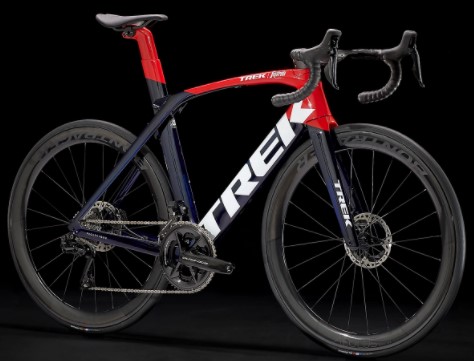
Trek Domane Overview: Who Should Get Domane?
Trek Domane is an endurance bike designed to go further, take on all-terrains and promote maximum stability.
This bike is perfect for touring, especially by seasoned riders. It enjoys a massive tire clearance, making it possible to fit broader tires. As a result, you can ride it off-road and not just on-road.
While Trek Madone is about aerodynamics and speed, Trek Domane is about comfort and stamina, thanks to its endurance geometry.
An endurance geometry enjoys a larger wheelbase that gives the bike extra stamina and a more relaxed layout to promote upright cycling, which feels more comfortable than someone in an aerodynamic position. Thus, it’s best for back issues.
In terms of travel distance, you can hit 10 miles (equivalent to 10 hours) with Trek Domane. So, it lives up to the name endurance.
Note, however, that while Trek Domane is good for all-terrain touring and for people with back issues, it’s not the best for racing as it’s slow.
However, unlike Madone, it can take on the climbs, thus being suitable for climbers.
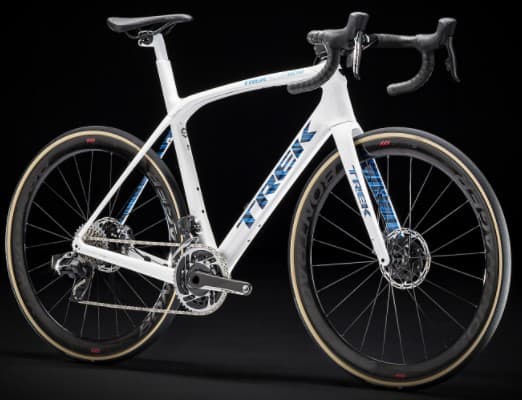
Trek Madone vs Domane Compared!
Before we can get into details, here’s a table summary showing the differences between Madone and Domane:
Trek Domane Vs Madone Detailed Comparison.
Now, let’s dig deeper into the differences between Madone and Domane:
1. Bike Type
Madone is an aero-race bike that employs aerodynamic principles, where your body assumes a low-lying position to resist wind drag and create enough momentum to ride fast.
In contrast, Domane is an endurance road bike built to withstand rough terrains and allow you to ride further (without necessarily being faster) but more comfortable.
2. Focus
Being an aero road bike, Madone focuses on aerodynamics and speed. The cycle is all about racing against the wind and doing it fast.
In contrast, Domane focuses on riding endurance and comfort. Its geometry (discussed next) enables you to ride longer without getting tired quicker.
3. Trek Madone vs Domane Geometry
Madone comes with a race geometry, which is slightly more aggressive than Domane’s endurance geometry.
Overall, a race geometry promotes faster riding and wind drag resistance, while an endurance geometry promotes comfort and stability.

4. Preferred Use
Madone’s race geometry makes it a better choice for road racing, especially on flatter grounds. You can, however, ride downslope seamlessly since the bike has an aerodynamic advantage. Note that while you can race with Madone and even go downhill, you’ll have a hard time going with it uphill.
In contrast, you’ll find Domane good for riding uphill but not the best for racing or downhill.
5. Preferred Terrain
Madone has a smaller tire clearance, often allowing you to fit a maximum tire size of 28c.
As a result, you can only fit slimmer tires, which are only best for on-road use. In contrast, Domane offers you a better tire clearance, allowing you to fit larger tires (up to 38c)
As a result, you can fit gravel bikes tires which allows you to go off-road. That makes Domane an all-terrain choice.
The other thing is that Madone’s race geometry allows you to lean a lot, and you need a smoother road to do it over long distances.
On the other side, Domane’s relaxed endurance geometry offers it more stability, allowing you to go over gravel and other minor obstacles. So, you don’t have to limit yourself to riding on-road as you can also do it off-road.
6. Speed
Madone’s aerodynamic advantage and race geometry make it speedier than Domane. Domane requires you to sit more upright, which means you are less likely to go faster.
So, if you want a bike to race with, especially on flats, go for Madone.
7. Bike Weight
Madone is slightly lighter than Domane. For example, the Madone SLR9 weighs 16.76 pounds, while Domane SLR9 weighs 17.2 pounds.
Essentially, Madone’s lower weight makes it speedier, while Domane’s slightly weighty build offers it more stability.
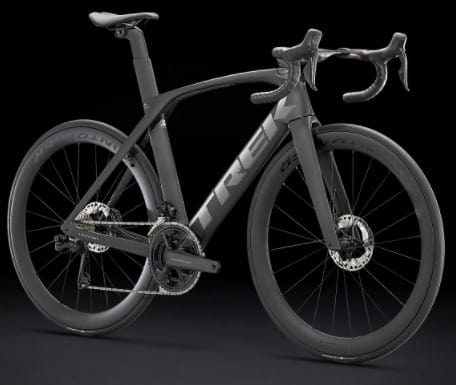
8. Trek Madone vs Trek Domane Models
Madone family.
Madone is available in two models; Madone SL and Madone SLR .
The Madone SL family features bikes with a 500 series OCLV carbon frame that’s pretty lightweight (though not as lightweight as Madone SLR). Bikes in this family promise a good value at a much affordable price.
On the other hand, Madone SLR features road bikes with an 800 series OCLV carbon. The frames are lighter than those of Madone SL and thus more high-end. The Madone SRR family is the racing-caliber family.
Domane Family
Unlike Madone, Domane is available in 3 families, all featuring different frame designs and promising different riding experiences. The families include the following:
- Domane SL – Domane SL family features 500 series OCLV carbon frames like Madone SL. The bikes are lightweight but not as light or high-end as Domane SLR.
- Domane SLR – Bikes in this category feature 700 series OCLV carbon making them the most high-end and lightweight in the Domane line. These bikes are the best climbers as they are the lightest.
- Domane AL – The Domane AL family features bikes with aluminum alloy frames. They are the most low-end and most budget-friendly in the Domane family. They are, however, better quality than most brands.
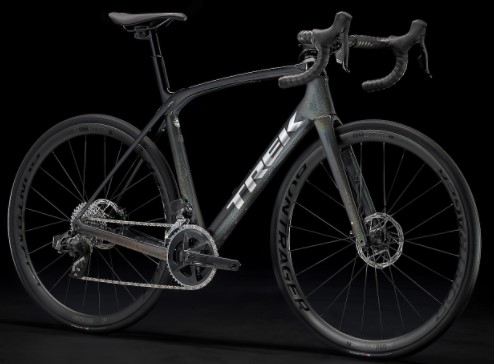
Trek Madone Vs Domane Similarities.
These two road bikes families resemble each other in many ways, given that the same manufacturer makes them.
While there’s a lot to pick from them, here are their standout similarities:
1. Bike Sizing
Trek employs the same sizing guide for all its road bikes, including Domane and Emonda. So, they currently make the two bikes in 8 frame sizes to suit different inseams and rider heights as shown in the table below;
2. Frame Warranty
Trek offers a limited lifetime warranty for Madone and Domane road bikes and other bike frames. That shows the bicycle manufacturer’s confidence in the quality of its artistry.
3. Bike Technology
Trek employs several technologies on both bike families, making them almost inseparable. First is the OCLV (Optimum-Compaction Low-Void) Carbon technology.
This 25-year-old frame technology promises super lightweight but stiffer and superior strength than other carbon frames.
The other technology that’s present on both bikes is IsoSpeed . IsoSpeed is a frame-integrated suspension technology that promises a stiffer, fatigue-resistant, and compliant bicycle.
IsoSpeed also enables the two road bikes to maintain their shape. More importantly, it promotes vibration-dampening making the bikes comfortable to ride on bumpy roads.
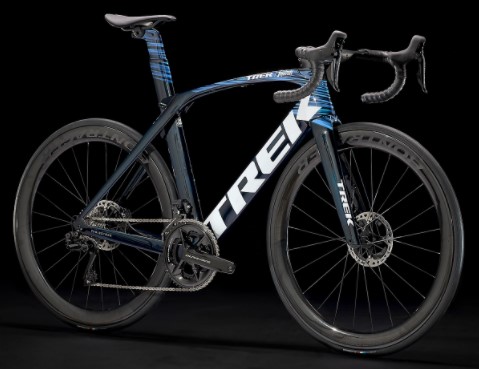
4. Project One Bike Customization
Trek allows you to customize its high-end Domane and Madone bikes. This opportunity enables you to create your dream road bike and make it as exquisite, speedier, and comfortable as you want.
It all starts with picking a frame paint scheme, bike family, and size and leaving the rest to Trek.
Trek Madone SLR9 Vs Domane SLR9 Compared.
Trek Madone SLR9 and Domane SLR9 represent the most high-end bikes by both families. So, it’s fair that we compare them. Here’s how the two road bikes compare:
Madone SLR9 is an aero-road bike, while Domane SLR9 is an endurance road bike
Even though both bikes feature OCLV carbon frames, Madone SLR9 features an 800 series OCLV carbon when Domane has a 700 series option. That makes Madone SLR9 slightly high-end.
- Tire Clearance
Madone SLR9 has a maximum tire size of 28c, while Domane SLR9 has a maximum tire size of 38c. That gives Domane SLR9 more tire clearance.
- Drivetrain
Both bikes feature a 12-speed Dura-Ace drivetrain which promises quick shifting for fast riding.
- Weight and Load Limit
While Madone SLR9 weighs 16.76 pounds, Domane SLR9 weighs roughly 17.2 pounds. That makes Domane SLR9 slightly heavier. Despite weighing differently, these two bikes have a load capacity of 275 pounds.
- Price
Madone SLR9 goes for $12,549.99 while Domane SLR9 retails at $12,249.99. That makes the Madone SLR9 slightly costlier than Domane SLR9.
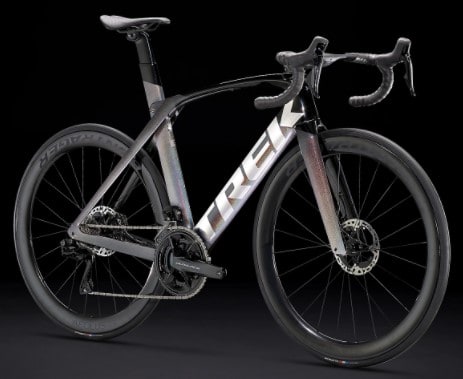
Below is a table of their comparison:
People also Ask
1. what is the difference between trek domane and madone.
The critical difference between Trek Domane and Madone is that Domane is an endurance road bike best for touring, while Madone is an aero-road bike best for racing and riding against the wind.
2. Which Is Better Domane or Madone?
Domane and Madone serve different purposes. Being an endurance bike, Domane is better for touring, while Madone is best for racing, especially against the wind, as it’s an aero road bike.
3. Is Trek Madone Comfortable?
Madone has an aggressive aerodynamic geometry which means you get to bend a lot. So, the bike is not comfortable for long distances.
Closing Thought on Trek Madone vs Domane!
Now you know what sets Domane and Madone apart. Overall, the Domane is a better tourer, while the Madone is a better racer. So, even though these bikes have many similarities, they are split primarily according to purpose.
Relevant: Trek Domane Vs Emonda !

Based on frame geometry and build specs.
A bike with lower gearing will be easier to ride up steep hills, while a higher top end means it will pedal faster down hills.
Domane SL 5
Émonda SL 5
(descending)
Based on build material and quality level of the frame, fork, wheelset, groupset, suspension system, and more.

IMAGES
VIDEO
COMMENTS
Trek Émonda: Lightweight Yet Aero Racing Bike Trek Émonda. Émonda is a lightweight road bike designed for racing. It has more performance geometry than Domane.. It's not as aero as Madone, but more aero than Domane. It's also lighter, making it ideal for climbing and riders who want an agile bike.. Since the 2021 redesign, it can be classified as a hybrid road bike (lightweight yet aero ...
The short answer. - The Emonda is a lightweight race bike for cyclists who like to go fast and ride aggressively. The lightness of Emonda is perfect for climbing because lighter bikes require less effort to get your bike up hills. - The Madone is a bit heavier than the Emonda but has an aerodynamic design that makes this bike great for flat ...
Trek Domane Compared to Emonda in Detail. Let's break down the above table below: 1. Bike Type. Trek Domane is an endurance road bike, while Trek Emonda is a race bike. The difference is that an endurance road bike is for riding further on different road surfaces, while a race bike is designed for racing on-road. 2.
Deciding Between Trek Road Bikes: An In-Depth Comparison. In a nutshell: The Emonda: A feather-light racing bike tailored for those who crave speed and an aggressive riding style. Its lightweight nature makes it a prime choice for uphill climbs, requiring less effort to conquer hills; The Madone: Slightly heavier than the Emonda, the Madone ...
The Trek Emonda is a lightweight bike for the high mountains. The lightest Trek Emonda frame weighs less than 700g using Trek's OCLV 800 carbon. This is the bike Richie Porte rode to his third place in the 2020 Tour de France. The SLR is the lightest and most expensive atop the Trek Emonda models. There are six Emonda SLR options, specced ...
If you are looking to get a Trek road bike but not sure which one, then this video is for you! In this video we compare the 2022/2023 Trek Domane, Trek Emond...
The Émonda is a great choice for riders who want a fast and responsive bike with balanced ride quality and superior handling for racing or for climbing steep hills. Prices range from £1,750 for the Émonda ALR 4 to £12,950 for the Émonda SLR 9 AXS. Trek Madone. The Madone is Trek's top-of-the-line aero bike designed for serious racers and ...
Here are some key differences between the two bikes: The Domane has a longer wheelbase than the Emonda, which makes it better suited for long rides. The Emonda has front and rear suspension, which makes it better suited for downhill riding. The Domane has a Shimano drivetrain, while the Emonda uses SRAM gears.
The Madone is Trek's most aerodynamic road bike. It's built for serious racers and riders who want the ultimate in speed and performance on the flat and more rolling routes. Madone is great for time trials, circuit and road racing or just going out for a blast on your favourite road. The new generation Madone made waves when it was unveiled ...
The Domane is Trek's endurance road bike, bred for comfort over long distances. This versatile workhorse features a slightly more relaxed and upright geometry compared to the Émonda and Madone. The Domane frame incorporates Trek's innovative IsoSpeed decoupler, which isolates the seat tube to provide up to 20mm of saddle movement to absorb ...
Trek Madone Vs Domane Similarities. 1. Both have Trek's race-proven geometry and IsoSpeed technology. 2. The Trek Madone and Domane are both built to be fast, efficient road bikes. ... Trek Emonda vs Trek Domane (Detailed 5 Technical Comparison) Trek Domane Sl5 vs Sl6 (9 Comprehensive Differences) Trek Fx vs Domane (7 Helpful Differences)
Trek Website: https://bit.ly/3OGJp4eWelcome to my first Trek road bike comparison!! This video describes all the main differences among the 2022 Trek Domane,...
Published on January 4, 2023. The Trek road bike range consists of three models (which amusingly are anagrams of each other 😉): Madone, Domane, and Emonda.The Trek Madone is the brand's aero star bike. In its recent versions, it features IsoFlow technology, a surprising cavity under the seat tube intended to improve aerodynamic penetration.
The Trek Madone is their aero-oriented bike where speed is the number one priority. With huge aerodynamically forged carbon tubes it cuts through the air like a hot knife through butter. These tubes create a super stiff and responsive ride that has proven to be popular over the years. With the latest iteration, the SLR, Trek have refined the ...
Now, Trek offers the Madone (aero bike), Domane (endurance bike), Emonda (lightweight race bike) and Checkpoint (gravel bike) as well as the Boone cyclocross and Speed Concept time trial machine ...
A Man Riding on a Trek Emonda (Trek Domane Vs. Emonda) Trek is one of the top bike manufacturers in the world, and the brand is responsible for designing a few high-end bikes that often compete at the world tour level. Trek specializes in designing road bikes for the most part, and they are known for their UCI team that competes in world tours.
Trek Emonda Vs Trek Domane - Similarities. The Trek Emonda and Trek Domane bikes are both made by the same company and feature many similar components. Both bikes have a lightweight frame, adjustable handlebar and stem, and a Shimano drivetrain. However, the Emonda is designed for road racing, while the Domane is designed for endurance riding.
Trek Domane 4/5. Weight may not be the primary concern with the Domane, and with Trek's IsoSpeed technology showcased both front and rear, it's no surprise that it's carrying a few extra grams compared to the Emonda. With that being said, it's no lead weight! Utilising Trek's OCLV 700 Series carbon, the SLR model equipped with 12-spd ...
Madone is slightly lighter than Domane. For example, the Madone SLR9 weighs 16.76 pounds, while Domane SLR9 weighs 17.2 pounds. Essentially, Madone's lower weight makes it speedier, while Domane's slightly weighty build offers it more stability. 8. Trek Madone vs Trek Domane Models.
Emonda is a mid to high end climbing bike. Built to be as light as possible and super stiff. Great for racing or just someone looking for a bike with a racier feel to it. It has a short wheelbase and quick handling. Domane is low to high end endurance bike built for comfort over speed. Still a very fast and light bike, but not as light as an ...
Specs. Domane SL 5 2021 Trek. Émonda SL 5 2021 Trek. Frame. 500 Series OCLV Carbon, front and rear IsoSpeed, internal storage, tapered head tube, internal cable routing, 3S chain keeper, DuoTrap S-compatible, mudguard mounts, flat-mount disc, 142x12 mm thru axle. BB Standard: T47, Threaded.